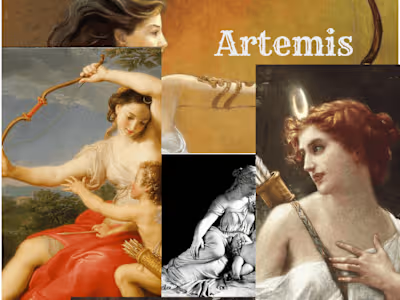From Creation to Compassion: The Five Goddesses of Japan
Kichijoten: The Goddess of Beauty
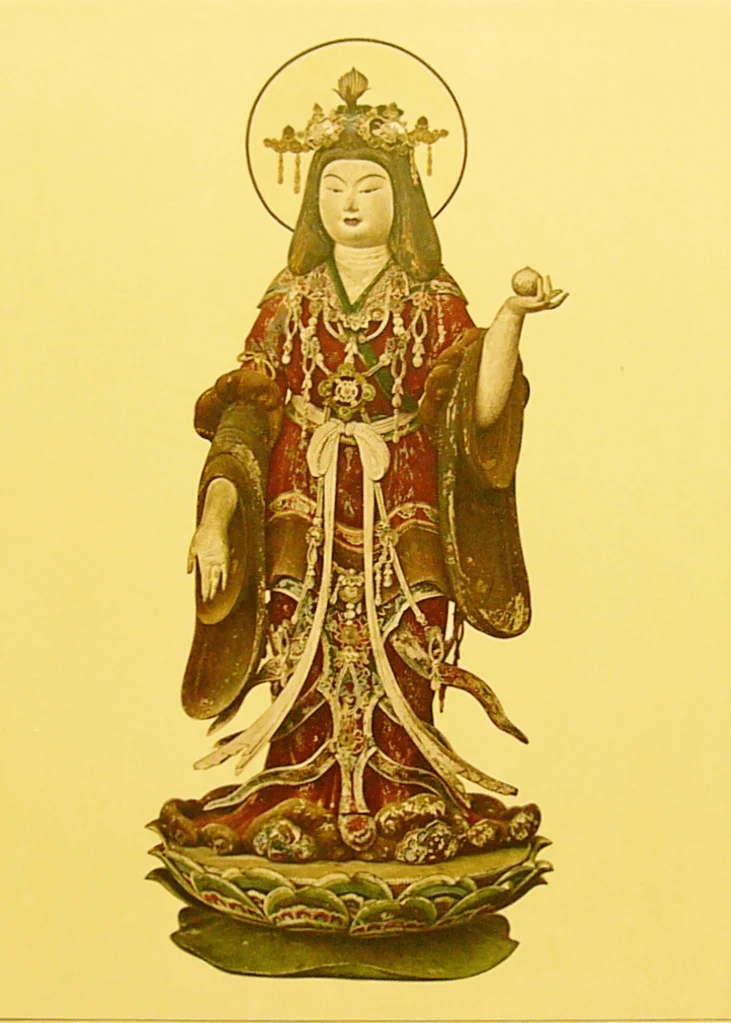
Source: Wikipedia
Japanese mythology features numerous deities, each possessing unique qualities and virtues. Among them is Kichijoten, the goddess of beauty, art, and abundance. Revered throughout Japan, Kichijoten is known for her elegance and blessings bestowed upon those who honor her. From her captivating stories, such as the legend of the flower blossom that brought beauty to barren lands, to the tale of the moon princess who fell in love with a mortal man. These stories hold profound significance and help us understand more about Japanese mythology and the impact Kichijoten had on the people of Japan.
Overview of Kichijoten
Kichijoten has many names, including Kisshoten (Heavenly Good Omen), Kisshotennyo (Heavenly Woman of Auspicious Good Fortune), and Kudokuten (Heavenly Virtuous Honors) (“Kichijoten”). All of these names emphasize her association with good fortune and prosperity. Furthermore, as one of the Seven Lucky Gods, Kichijoten occupies a special place in the hearts of the Japanese people. Devoted followers celebrate Kichijoten through various festivals and rituals dedicated to her, where people come together to honor her and seek her blessings. Through these practices, Kichijoten’s influence extends beyond mere mythology and into the lives of those who revere her.
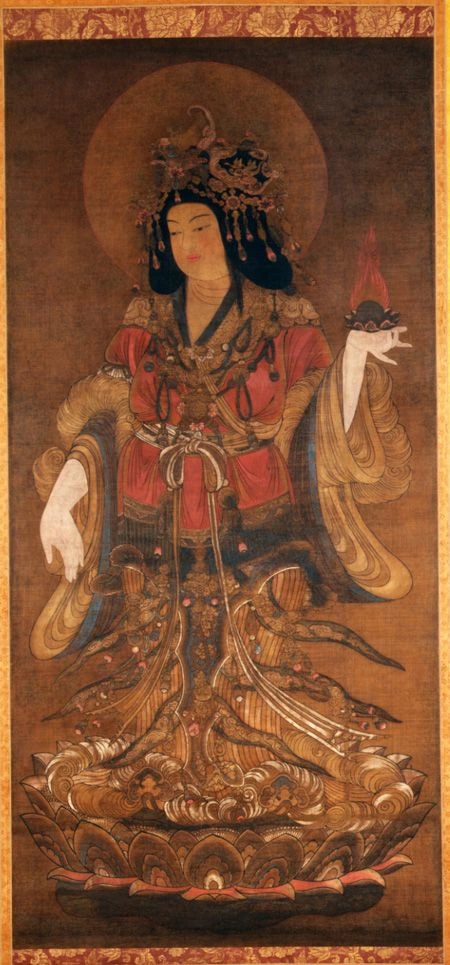
Source: Pinterest
Titles
Goddess of Beauty
Guardian of the Arts
Granter of Prosperity and Fertility
Bestower of Longevity and Happiness
Protector of Love and Compassion
Abilities
Kichijoten, the revered goddess of beauty, is believed to possess many extraordinary abilities. Her unparalleled beauty and allure captivate all who encounter her, and her benevolent influence extends to various domains. She is credited with the power to bring abundance and prosperity into the lives of her devotees and is associated with fertility, and bestowing blessings upon couples seeking children. Kichijoten is worshiped primarily by women, as all of her domains intersect with women, and this is partly her inheritance from Lakshmi (“Kichijoten”). Moreover, her benevolent influence extends to the realm of art, where she inspires creativity and artistic endeavors, encouraging artists to channel their talents for the benefit of humanity.
Characteristics
The goddess is often depicted as an exquisitely beautiful being with fair skin and captivating features. Her graceful bearing and ethereal charm make her the embodiment of elegance and allure. Kichijoten often has long hair, symbolizing vitality and abundance, and commonly wears ornate robes adorned with vibrant colors and intricate patterns, reflecting her association with art and beauty. In her hand, she often holds a peacock feather or a gem emblem of her divine presence, the feather being a symbol of beauty and good fortune, and the Nyoihoju gem appears in both Indian and Japanese art, having the power to grant wishes (Greenberg and PhD).
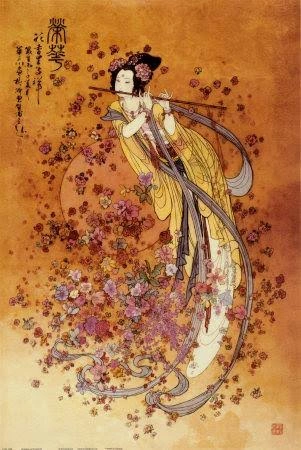
Source: Allposters
Traits
Kichijoten is known for her compassionate and kind nature, as well as her deep love for humanity. She embodies the qualities of a loving mother figure, offering comfort and guidance to those who seek her aid. Her ability to inspire love and foster harmonious relationships among individuals is widely admired, and her grace and wisdom are considered to be of great value. Kichijoten’s benevolent spirit is rooted in a deep understanding of human desires, and she is driven by a desire to bring happiness and fulfillment to all. With her gentle and nurturing demeanor, Kichijoten is revered as a powerful force for good, offering support and guidance to all who seek it.
Symbols
Kichijoten holds immense significance and influence in all aspects of beauty, prosperity, and good fortune. The goddess is symbolized by many things, with the peacock being the most prominent symbol. The peacock’s iridescent feathers represent the goddess’s regal appearance and the ability to captivate with its vibrant hues. Additionally, the Nyoihoju gem is another symbol associated with Kichijoten. Commonly referred to as hōju, hōju-no-tama, or nyoi houju in Japan, this jewel holds immense significance as it bestows blessings upon those who suffer. It is said to grant wishes, pacify desires, and bring a clear understanding of the Dharma or Buddhist law (“The Wish-Fulfilling Jewel”). The Nyoihoju gem is a powerful symbol of Kichijoten’s benevolence and her desire to bring joy and good fortune to all those who seek her blessings.
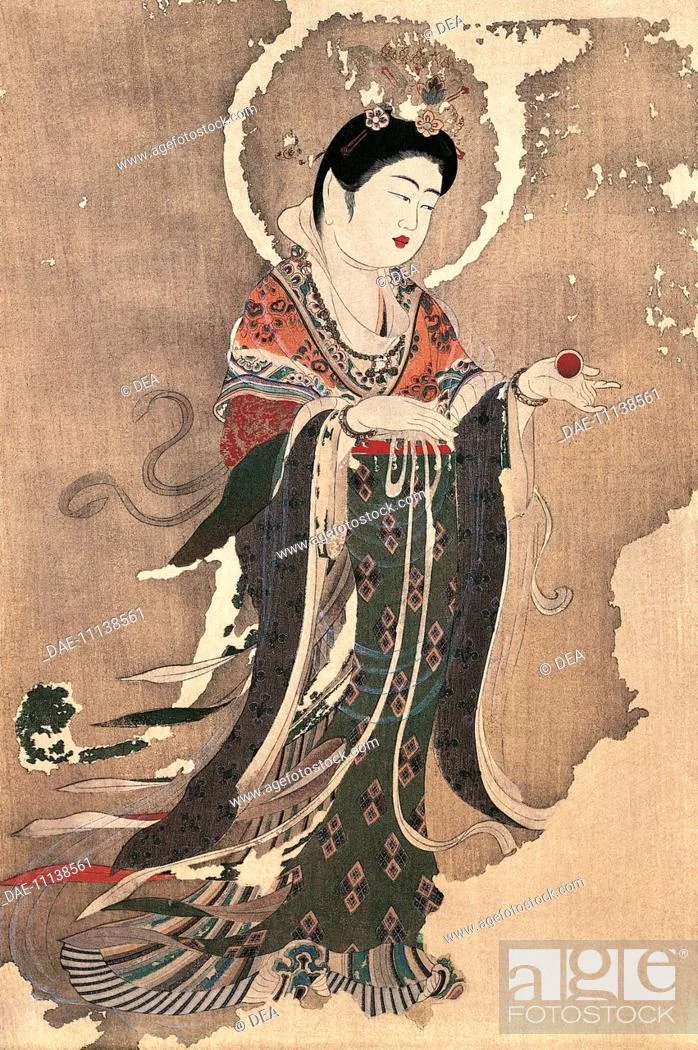
Source: Agefotostock
Festivals and Rituals
In Japan, Kichijoten is celebrated annually during the Kisshouten Matsuri festival in various regions of Japan. The festival serves as a platform for people to express their devotion and gratitude to the goddess of beauty and arts. The word “Matsuri” refers to comfort, prayer, and the expression of gratitude to the ritual of Nature, and it originates from the indigenous God (Shamanism), Shinto, or Buddhism (“What Is the Matsuri (Japanese Cultural Festival)? – ANA”). During the vibrant celebration, participants engage in traditional dances, music performances, and art exhibitions, all paying homage to Kichijoten. The festival provides a showcase for artists to exhibit their talents and express gratitude to the goddess. Devotees also offer prayers and make offerings at shrines dedicated to Kichijoten, seeking her blessings for prosperity, fertility, and happiness in their lives.
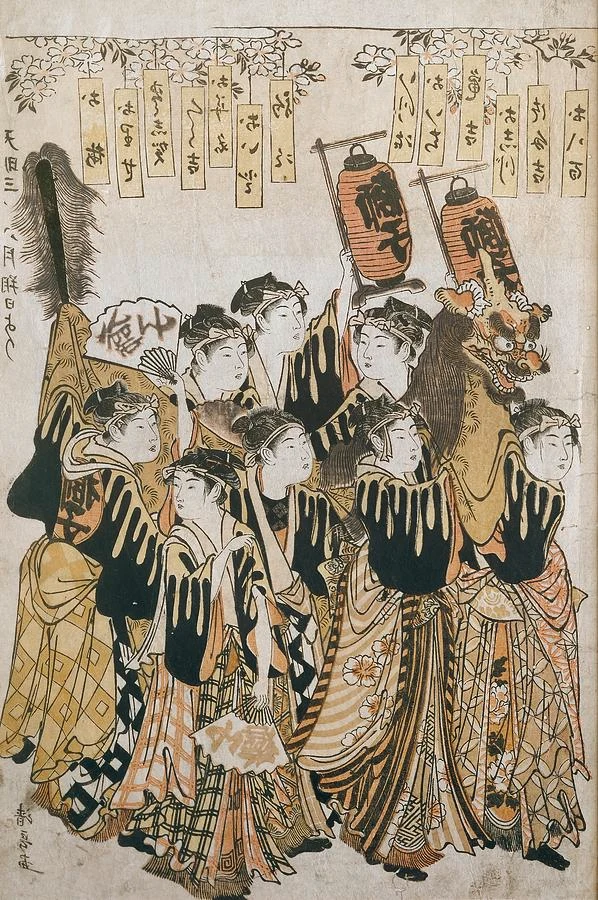
Source: Pixels
Legends associated with Kichijoten
The fascinating mythology and cultural significance of the Japanese goddess Kichijoten can be seen through the legends surrounding her. Known as the embodiment of beauty, art, and abundance, her origins and tales have captivated generations of worshippers. This section delves into the enchanting legends surrounding Kichijoten, shedding light on her creation and showcasing her enduring influence across different narratives.
Origin story
There are multiple versions regarding the origin of Kichijoten, a goddess known for her association with beauty and fertility. One such interpretation suggests that she is a fusion of earlier goddesses, including the Indian goddess Lakshmi and the Buddhist goddess Hariti. This conflation of deities reflects the influence of various religions, notably Buddhism, on the formation of Kichijoten’s character and attributes (“Kichijoten”). The amalgamation of diverse cultural and religious elements contributed to developing her unique identity as the goddess of beauty and abundance.

Source: Britannica
The Blossom of Beauty
As per a widely known tale, the followers of Kichijoten knew of her powers to bestow beauty upon those she favored. The story goes that a young lady named Otohime was deeply worried about her village, which was facing a severe drought, leading to a lack of crops and dwindling beauty among the villagers. Otohime sought the blessings of the goddess of beauty, and her sincere prayers drew the attention of Kichijoten, who appeared before her as a stunning woman holding a peacock feather. The goddess was impressed by Otohime’s sincerity and gave her the task of planting the feather in the heart of the village. Kichijoten promised Otohime that beauty would blossom alongside the peacock feather when it took root. Otohime followed the instructions obediently and planted the feather as directed. Soon enough, the village transformed into a haven of natural and human beauty, blessed by the goddess of beauty, Kichijoten. The beauty of the people and the surroundings were restored, and the villagers were overjoyed with the transformation that had taken place (“Kichijoten”).
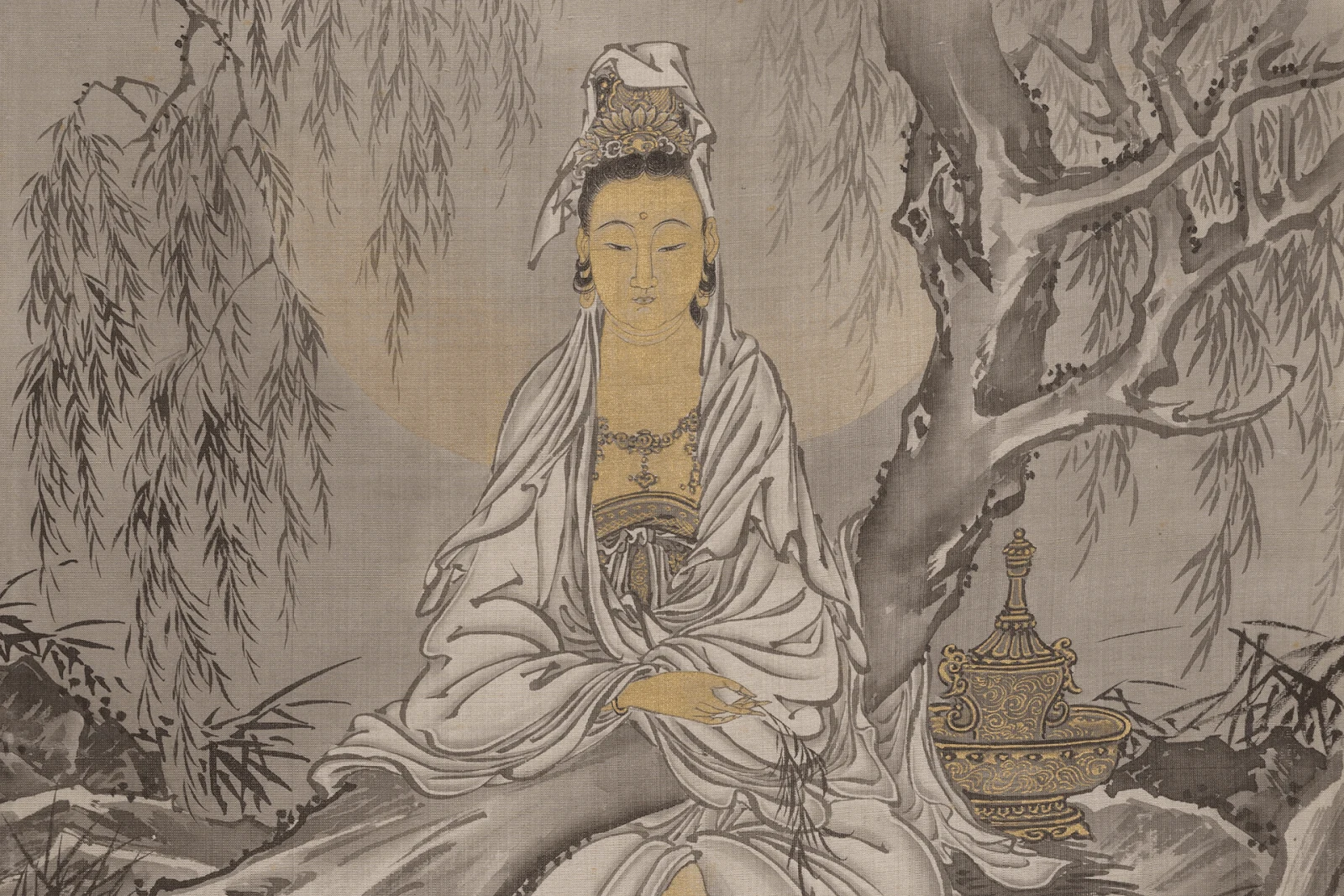
Source: Mythopedia
The Moon Princess and the Celestial Realm
According to ancient folklore, there is a tale of a moon princess who fell in love with a mortal man. However, their love was forbidden, and the princess could not join her beloved on Earth. In her desperation to be with him, the moon princess turned to Kichijoten, the goddess associated with love, beauty, and the arts, for assistance. Moved by the couple’s sad circumstances, Kichijoten decided to intervene. The goddess granted the moon princess the ability to visit her lover during the cherry blossom season when the boundaries between the celestial realm and the mortal world were thin. As the cherry blossoms bloomed, symbolizing the fleeting beauty of life, the moon princess would descend to Earth and reunite with her lover under Kichijoten’s watchful gaze. This enchanting legend beautifully highlights the goddess’s connection to love, romance, and the ephemeral beauty of nature (Greenberg and PhD).
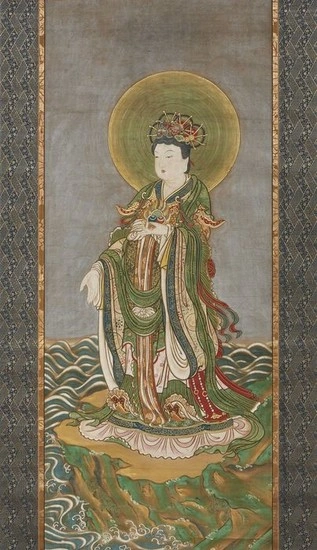
Source: Lot-art
Influences of other religions/cultures on Kichijoten
Kichijoten, the Japanese goddess of beauty, fertility, and benevolence, is a fascinating example of how different religions and cultures can influence each other. As Buddhism became more prominent in Japan, Kichijoten’s character and attributes intertwined with Buddhist iconography. In some depictions, she was a manifestation of Avalokitesvara, the bodhisattva of compassion. This syncretic approach to religion, where deities from different traditions come together to create a cohesive spiritual landscape, is a defining feature of Japanese religious practices. Incorporating Kichijoten into Buddhist beliefs solidified her role as a symbol of beauty, fertility, and benevolence. Overall, Kichijoten’s story is a testament to the power of cross-cultural exchange and the richness of embracing diverse perspectives (“Discover the Beauty and Mystery of the Japanese Goddess of Beauty: Kichijoten – Old World Gods”).
Modern appearances
Throughout history, Kichijoten has symbolized everything that has to do with beauty, artistry, and prosperity. Her influence embeds itself through many forms of artistic expression, from traditional paintings and sculptures to modern-day manga and anime. As a central figure in beauty rituals and practices, people have sought her blessings for physical attractiveness and a radiant aura. Despite being less well-known than some of the other members of the Seven Lucky Gods, Kichijoten’s influence is still present in various forms of popular culture. For instance, in CLAMP’s manga RG Veda, Kisshoten is depicted as the wife of Bishamonten and the daughter of the former king, who remains loyal to her husband despite his questionable behavior. Overall, Kichijoten remains a captivating and intriguing figure whose legacy lives on (“Kichijoten”).
Final thoughts
Kichijoten, the alluring Japanese deity of beauty, artistry, and abundance, continues to captivate and inspire individuals with her divine presence. As the patroness of artists, a granter of blessings, and an embodiment of beauty, Kichijoten remains a crucial figure in Japanese mythology and culture. The festivals and rituals devoted to her are lively expressions of devotion and gratitude, ensuring that her influence endures across generations. By embracing the spirit of Kichijoten, people are encouraged to seek inner beauty, foster their creativity, and manifest prosperity in their lives, ultimately embodying the divine essence of this revered goddess in their daily pursuits.
References
“Discover the Beauty and Mystery of the Japanese Goddess of Beauty: Kichijoten – Old World Gods.” Oldworldgods, 11 June 2023, oldworldgods.com/japanese/kichijoten-goddess-of-beauty/. Accessed 11 July 2023.
Greenberg, Mike, and PhD. “Kichijoten: The Lucky Goddess of Beauty.” Mythologysource, 21 Dec. 2020, mythologysource.com/kichijotenl-japanese-goddess/.
“Kichijoten.” Mythopedia, mythopedia.com/topics/kichijoten.
“The Wish-Fulfilling Jewel.” JAPANESE MYTHOLOGY & FOLKLORE, 10 Dec. 2012, japanesemythology.wordpress.com/the-wish-fulfilling-jewel/#:~:text=Known%20as%20the%20h%C5%8Dju%20%E5%AE%9D%E7%8F%A0. Accessed 11 July 2023.
“What Is the Matsuri (Japanese Cultural Festival)? – ANA.” ANA, 2018, www.ana.co.jp/en/kh/japan-travel-planner/japanese-festival-omatsuri/0000001.html#:~:text=The%20original%20purpose%20of%20the. Accessed 11 July 2023.
Inari: The Goddess of Prosperity, Rice, and Agriculture
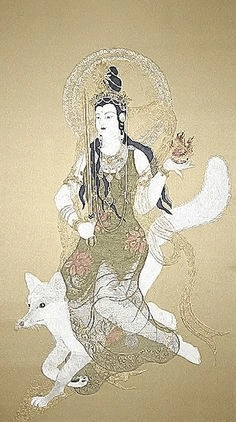
Source: Pinterest
In the rich tapestry of Japanese mythology and culture, one deity stands out above all others - Inari, the divine patron of prosperity, rice, and agriculture. This revered figure is honored through lively festivals and takes on both male and female forms, each with its unique names, attributes, and symbols that reflect their intricate nature and divine abilities. From their origins in ancient lore to their role in saving Japan from famine, Inari has earned a place of honor and reverence, with more shrines dedicated to their worship than any other kami in Japan.
Overview of Inari
Inari is a revered goddess in Japanese mythology, deeply ingrained in the country's agricultural heritage. The goddess of prosperity takes many names, such as Ō-Inari, Ukanomitama-no-kami, and Omiyanome-no-kami. Inari is rooted in the word ine, meaning rice seedling, and translates to 'rice carrier' (“Inari”). Inari's influence extends to the prosperity of farmers and merchants, serving as a guardian deity who protects crops from harm and ensures bountiful yields for her devoted followers. To this day, her legacy carries on as she remains highly respected and celebrated in Japanese culture.

Source: Mythopedia
Titles
The Queen of Rice Fields
Patroness of Farmers and Merchants
Goddess of Prosperity and Abundance
Bringer of Fertility and Wealth
Guardian of Agriculture and Grain
Abilities
According to ancient Japanese folklore, Inari, the patron goddess of agriculture and prosperity, possesses many divine powers. Among these abilities, Inari has the power to bestow bountiful harvests, bring financial success, and safeguard agricultural endeavors against misfortune and disasters. Furthermore, Inari's influence extends beyond agriculture, as she possesses healing powers capable of curing many afflictions, including coughs, toothaches, broken bones, and syphilis (“Inari - New World Encyclopedia”).
Characteristics
In Japanese illustrations, the deity Inari takes diverse forms, including male and female representations. Scholar Karen Ann Smyers reports that the most widespread depictions of Inari are those of a youthful female food goddess, an elderly male carrying rice, and an androgynous bodhisattva. It is essential to note that no one form of depiction is incorrect, as gender preference varies depending on regional traditions and individual beliefs. Notably, Inari is extensively associated with kitsune, the fox, symbolizing their affiliation with the spiritual realm. As a result, many illustrations of Inari typically feature foxes (“Inari”).
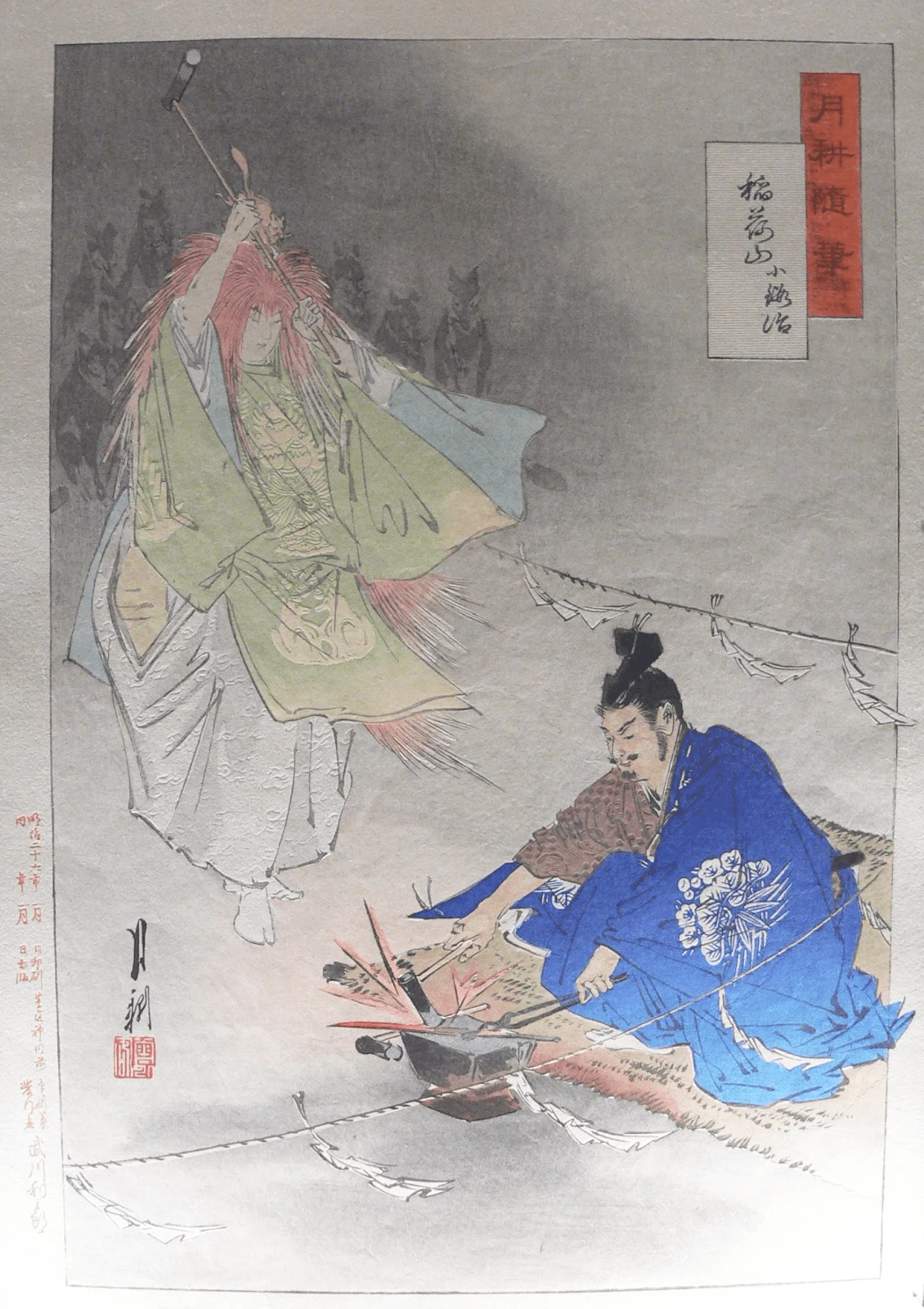
Source: Wikipedia
Traits
The goddess embodies many positive qualities, including generosity, empathy, and nurturing nature, all of which contribute to the well-being and prosperity of her devoted followers. Inari is celebrated for her unwavering kindness towards humanity and fiercely protects and supports those who worship her. The goddess's commitment to the betterment of her worshippers is a testament to her divine power and influence.
Symbols
Inari is a prominent figure in Japanese folklore, and their attributes and influence are often visually represented through various symbols. One of the most well-known symbols of Inari is the fox, or kitsune, which is a supernatural creature in Japanese mythology. Kitsune is a messenger or divine familiar (“Inari”), and it is no surprise that this creature is associated with Inari, as the deity is a protector of agriculture and fertility.
Another symbol commonly associated with Inari is rice, as she is known as The Queen of rice fields. Rice bags are a significant symbol representing Inari's connection to agriculture and rice cultivation. Offering these items to Inari is seen as a sign of devotion and a desire for abundance. Additionally, torii gates are another important symbol that is associated with Inari. These gates are at the entrance of Shinto shrines dedicated to Inari and represent the boundary between the human world and the spiritual realm.
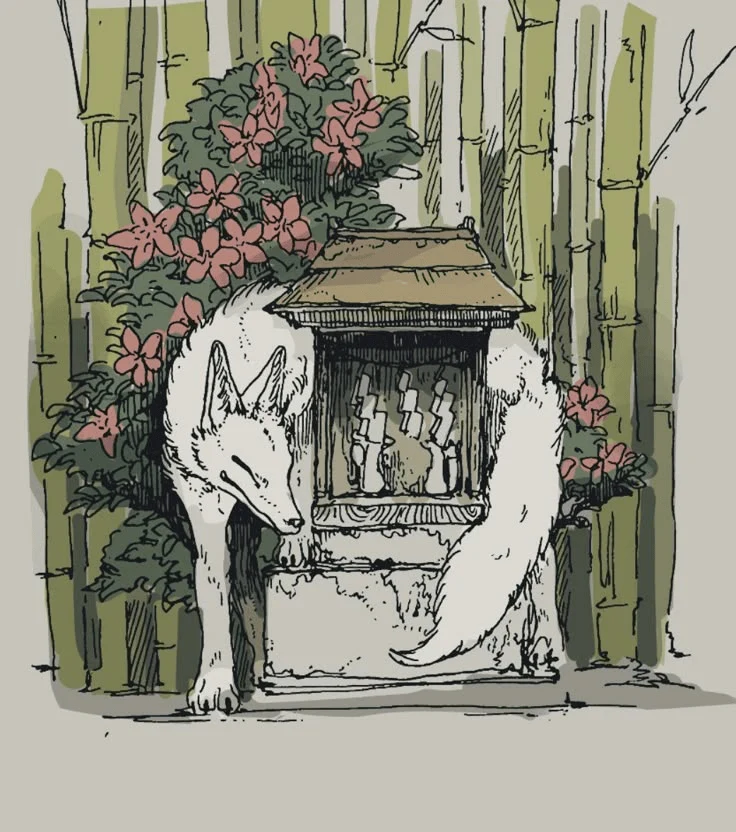
Source: Pinterest
Festivals and Rituals
The worship of Inari is deeply ingrained in Japanese culture and consists of a series of vibrant festivals and rituals held throughout the year. Across Japan, there are over 40,000 shrines dedicated to the god, ranging from small local shrines to grand, elaborate structures. Perhaps the most famous of these is the Fushimi Inari Shrine near Kyoto. The shrine is considered the oldest and most important shrine dedicated to Inari. Here, visitors can marvel at the shrine's impressive red torii gates and fox statues, which honor the animal that serves as Inari's messenger and guardian (“Inari”).
One of the most highly anticipated events in the Inari worship calendar is the O-Inari-san Festival, which takes place annually at the Fushimi Inari Taisha in Kyoto. Devotees gather from all over the country to pay homage and offer prayers to Inari, seeking blessings for prosperity, business success, and good fortune. The festival includes an array of intricate rituals, including the presentation of rice, sake, and symbolic items, as well as expressions of gratitude and requests for favor from the goddess.
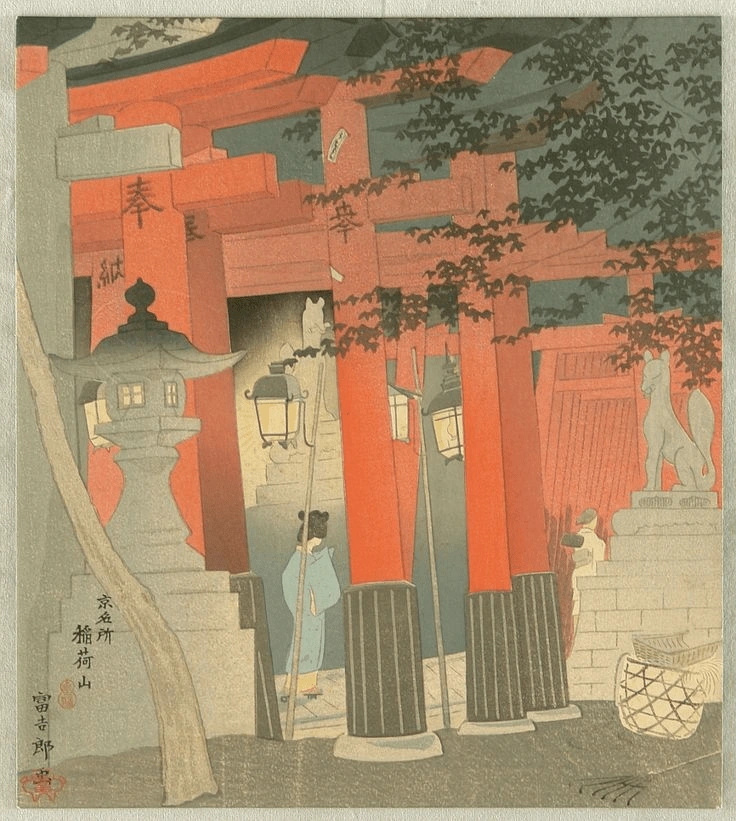
Source: Pinterest
Legends associated with Inari
The revered deity Inari, whose influence extends to prosperity and agriculture, has an intriguing history filled with captivating legends. The legends passed down over generations provide a window into the mystical origins of this goddess. By connecting Inari to Japan's cultural and spiritual heritage, these stories deepen our understanding of the deity and her significance.
Origin story
The origin of Inari, a deity in the Shinto religion, has been a topic of interest among various sources and folklore. One prevalent account suggests that Inari was born from the divine union of the gods Izanagi and Izanami. According to this myth, Inari emerged alongside her siblings as part of the pantheon of Shinto deities, representing fertility, agriculture, and prosperity.
Another variation proposes that Inari was first worshiped on Mount Inari in the 8th century following an intriguing discovery by a man named Hata no Irogu. As the story goes, Irogu was practicing his archery skills using sticky rice cakes (mochi) as targets when one of his shots hit directly through a cake, which magically transformed into a white dove. Fascinated, Irogu followed the bird, which landed on a peak of Mt. Inari called Mitsumine. There, he discovered rice growing and began to worship Inari as a spirit or Shinto kami, seeing Inari as the deity of rice, agriculture, and prosperity (“Inari”).
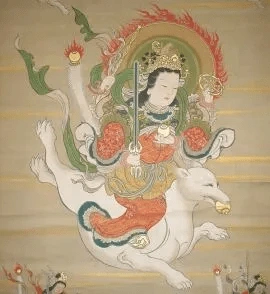
Source: Journeying to the Goddess
Saving Japan From Famine
According to legend, Inari descended from the heavens and arrived in Japan during a great famine. As she rode a magnificent white fox, she carried with her sheaves of cereal or grain. Interestingly, the term "Ine," used today to refer to rice, was the name of the cereal that she brought with her. This cereal was not rice but grain that grew in swamps. According to the legend, during ancient times, Japan was mostly swamp and water land, which makes it all the more fascinating to imagine the scene of Inari arriving on her white fox, bearing the gift of life-giving cereal (Wikipedia Contributors).

Source: Study
Influences of other religions/cultures on Inari
Throughout history, Inari's veneration has been shaped and influenced by the syncretism of religious practices adopted over time. Of particular note is the introduction of Buddhism to Japan, which impacted the perception and recognition of Inari. This impact led to establishing Buddhist temples and statues close to Inari shrines, resulting in a fusion of beliefs and blurring the lines between the two. Over time, Inari became increasingly associated with the Buddhist figure Dakiniten, the goddess of harvest and fertility (Wikipedia Contributors). This association expanded Inari's role and attributes and cemented her place in Japan's cultural and spiritual landscape.
Modern appearances
In contemporary media, Inari is a popular character in manga, anime, and video games, often symbolizing wealth and good fortune. One example is the Persona series, a spinoff of the larger Megami Tensei video game franchise. In the game, Yusuke Kitagawa (inspired by Inari) dons a fox mask and tail (4).
In the World of Darkness role-playing game universes, kitsune, the legendary fox spirits, are present in both the classic World of Darkness and the follow-up Chronicles of Darkness. In the latter, kitsune are changing breeds whose unique abilities are bestowed upon them by Inari (4).
Final thoughts
The goddess Inari is highly esteemed among the Japanese people. Her story is steeped in legend, featuring mystical fox messengers and a magical rice sack, which illustrate her role as a provider of prosperity and protector of agriculture. As various religious practices and Buddhism merged, Inari's significance evolved and changed because of the development of new customs. Even today, Inari's cultural importance extends beyond ancient traditions and remains relevant in contemporary contexts, showcasing the enduring influence of this venerated deity.
References
“Inari.” World History Encyclopedia, www.worldhistory.org/Inari/.
“Inari.” Mythopedia, mythopedia.com/topics/inari.
“Inari - New World Encyclopedia.” Www.newworldencyclopedia.org, www.newworldencyclopedia.org/entry/Inari.
Wikipedia Contributors. “Inari Ōkami.” Wikipedia, Wikimedia Foundation, 27 Dec. 2019, en.wikipedia.org/wiki/Inari_%C5%8Ckami.
Benzaiten: The Goddess of Luck and Love
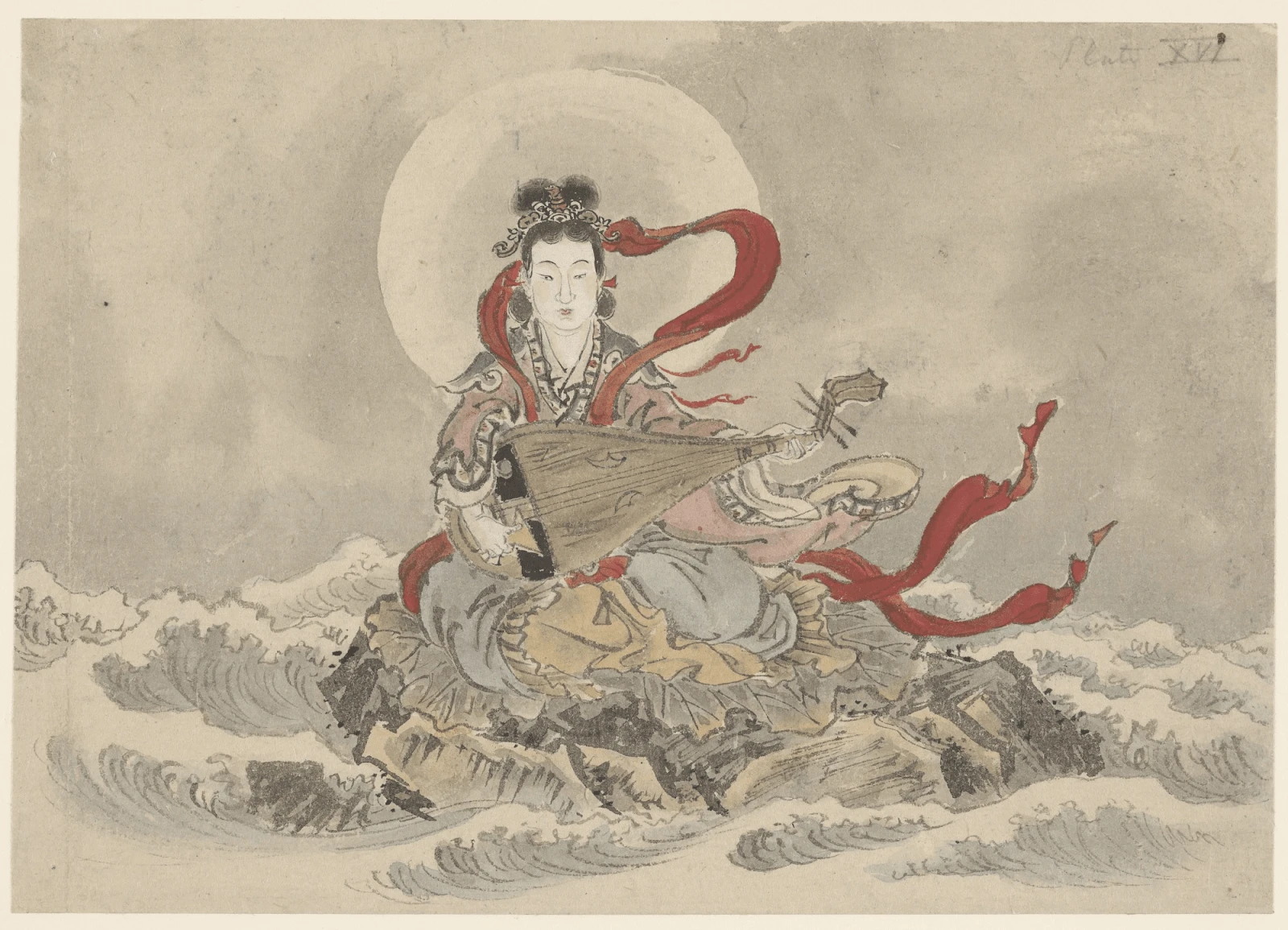
Source: National Museum of Asian Art
In the rich tapestry of Japanese mythology, there is the goddess of luck and love, Benzaiten. As goddess of all that moves and flows, Benzaiten is the Shinto kami of lakes, rivers, and the sea. However, her domain extends beyond just the realm of water, as she is also the goddess of eloquence, music, poetry, speech, and wealth. Throughout history, Benten has been the subject of various literary works, from The Legend of Enoshima to the 14th-century Noh play entitled Chikubushima. Whether it is the power of her words, the beauty of her music, or the wisdom of her teachings, Benzaiten is a figure who has left an indelible mark on the people of Japan, and her legacy continues to inspire and guide them to this day.
Overview of Benzaiten
The Shinto deity has many names: Benzaiten, Benza-tennyo, and Benai-ten, but most call her Benten. (Writers) Originating as a manifestation of the Indian goddess Sarasvati, Benzaiten has evolved, adapting to different landscapes, regions, and historical periods. Throughout the centuries, Benzaiten has emerged as a prominent emblem of religious syncretism within Japanese culture, seamlessly integrating elements from diverse religious traditions: she is a goddess in the two major religions of Japan, Shinto, and Buddhism. As a result, she has become an enduring symbol of Japan's unique blend of cultural influences. Her influence can be seen in everything from art and literature to popular culture and daily life, making her an influential figure for spiritual and secular Japanese communities.
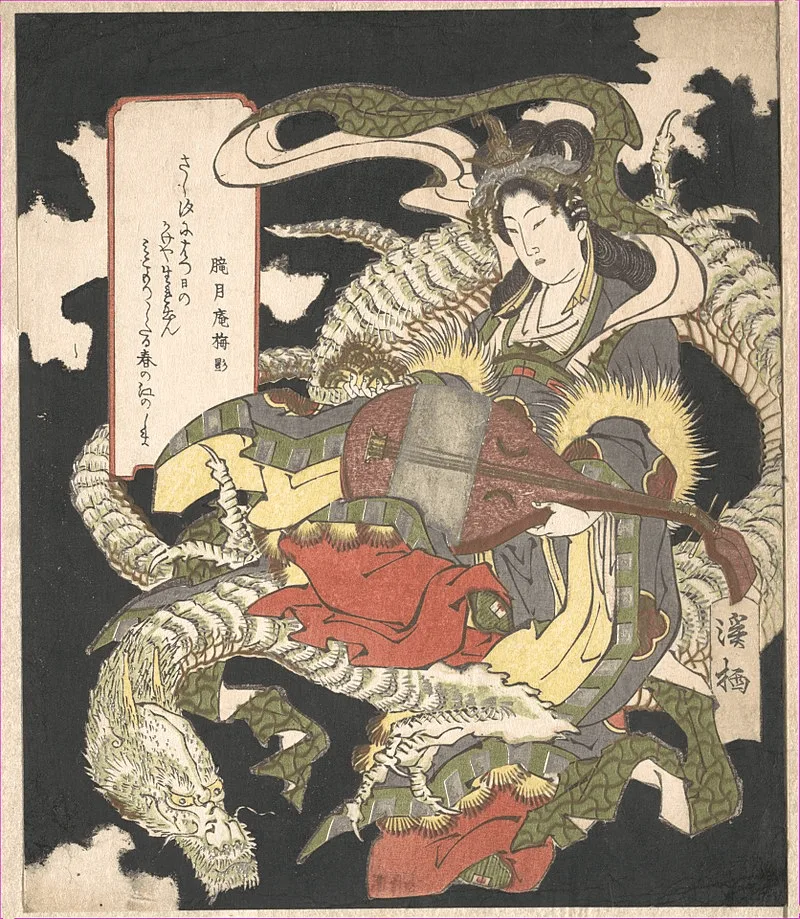
Source: Wikipedia
Titles
Goddess of Love and Luck
Benzaitennyo (Goddess who dispenses wisdom) (“Benzaiten”)
Myoonten, (Goddess of Wonderful Sounds) (“Benzaiten”)
Ichikishima-hime-no-mikoto (Heavenly Princess Ichikishima) (“Benzaiten”)
Abilities
Benzaiten is both a Buddhist goddess and a Shinto Kami. As a goddess of love and luck, she is renowned for her association with luck and wisdom, bestowing insightful counsel and good fortune upon those she favors. As the only female deity in the group of Seven Lucky Gods, she spreads prosperity, compassion, and auspiciousness among the people of Japan alongside the other six lucky gods.
Characteristics
Benzaiten, a revered deity, is often portrayed as a stunning female figure, embodying the quintessence of beauty and femininity. Her attire varies in different portrayals, ranging from a courtesan's attire to the modest robes of a nun. However, her most notable symbol is the biwa, a traditional Japanese flute-like instrument, which signifies her association with music and the arts. In addition to her musical abilities, her depictions display varied Buddhist halos and other sacred symbols that highlight her divine nature and spiritual importance. (“Benzaiten”)
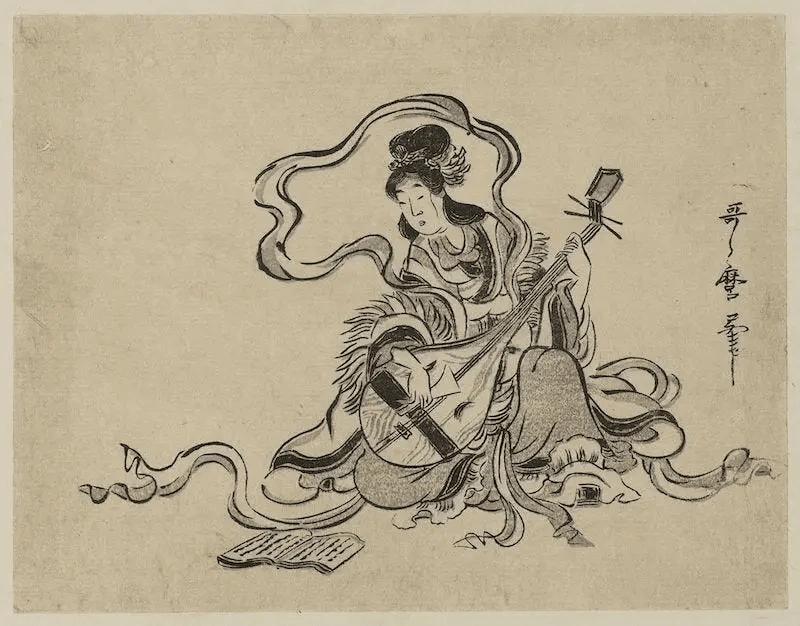
Source: Donny Kimball
Traits
The character of Benzaiten shares many similarities with Sarasvati, a goddess from Indian mythology. (Fisher) Both revered figures are known for their association with wisdom, learning, and knowledge, Benzaiten, in particular, is known for her compassionate and merciful nature. Along with her generosity, Benzaiten is revered for showing kindness and empathy towards her followers, granting them blessings and protection in times of need.
Symbols
Benten is associated with many symbols, which signify her distinct roles as a Shinto deity. Her central symbol, however, is water. Followers of Benzaiten believe that she has control over water and influence over the tides: her affinity with water is why her shrines are near lakes and rivers. Another symbol is the biwa which represents her association with music, art, and creativity. Benten's connection to art and music is in the many festivals held in her honor, which feature performances and displays of artistic expression. Overall, the symbols associated with Benten reflect her multifaceted nature and how she has influenced Japanese culture and society.
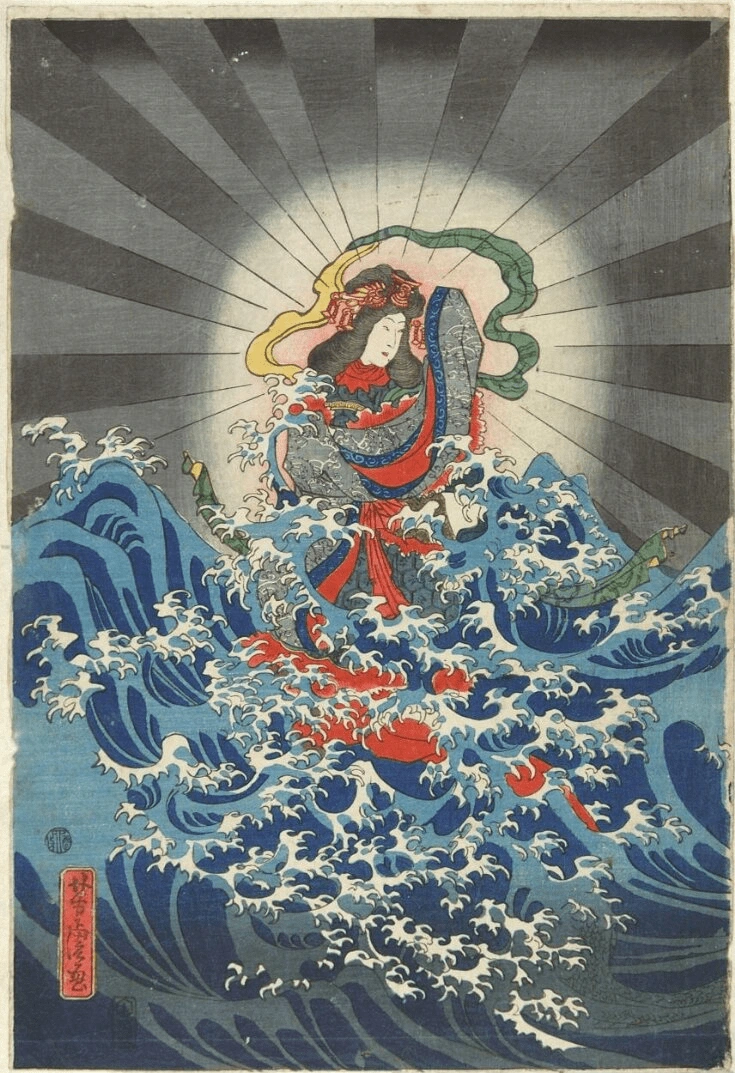
Source: Vam
Festivals and Rituals
Even today in Japan, numerous shrines dedicated to Benzaiten can be found, with the three most prominent being the Itsukushima Shrine located in Hiroshima prefecture, the Enoshima Shrine situated in Kanagawa prefecture, and the Hogan-ji Temple located in Shiga Prefecture. The famous Legend of Enoshima took place on Enoshima Island, where the Zeniarai Benten Ugafuku Shrine is. The cave shrine is one of the remaining shrines in Japan that uniquely blends Buddhism and Shinto practices, making it a truly unique experience for all visitors. (link et al.)
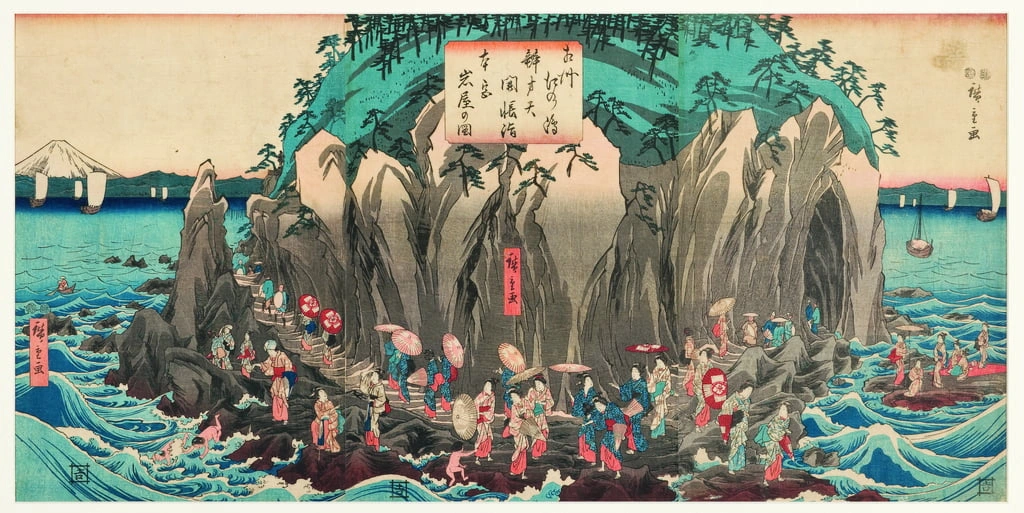
Source: Meisterdrucke
Legends associated with Benzaiten
Originating from Hinduism, Benzaiten is a revered figure in both Shinto and Buddhism. As such, she has a plethora of legends associated with her, each reflecting the diverse cultures and religions from which she draws her influence. For our purposes, we will be delving into Benzaiten's role in Japanese Mythology, specifically through the famous Legend of Enoshima and the 14th-century Noh play entitled Chikubushima. By exploring these tales, we better understand the complex and intriguing nature of the goddess of love and luck.
Origin story
The goddess Benzaiten is a revered figure in Shinto and Buddhism, but she was born from Hinduism. The goddess has roots that trace back to the Indian goddess Sarasvati. Interestingly, Benzaiten is a Chinese interpretation of Sarasvati's name, as found in the Golden Light Sutra, highlighting the goddess's global significance. (Writers) Like Sarasvati, Benzaiten is known for her many virtues, including wisdom, love, and beauty. Moreover, despite originating from a religious background not native to Japan, the Shinto deity integrated seamlessly into Japan's culture over time.
Benzaiten first arrived in Japan during the Asuka period, from 538 to 710. During this time, Buddhism and the Golden Light Sutra had also reached Japan, and Benzaiten's presence was noted by 552 when a comet associated with her brought good fortune to Japan. As Buddhism gained popularity among the Imperial Family, so did Benzaiten's worship. She became one of the Seven Lucky Gods, and nobles and peasants worshiped her. In certain regions, she was merged with local kami related to rivers and islands, further cementing her place in Japanese mythology and culture. Over time Benzaiten's popularity grew, particularly among urban dwellers such as court musicians and courtesans. During the Tokugawa era, from 1600 to 1868, Benzaiten became associated with wisdom, a virtue for the ruling samurai class. Despite the demonization of Buddhism as a "foreign religion" during the Meiji Restoration and the rise of State Shinto, Benzaiten's devotees remained intact. Her well-developed roots in Shinto traditions and Japanese culture allowed her to face less neglect when compared to other foreign religious influences. (Writers)
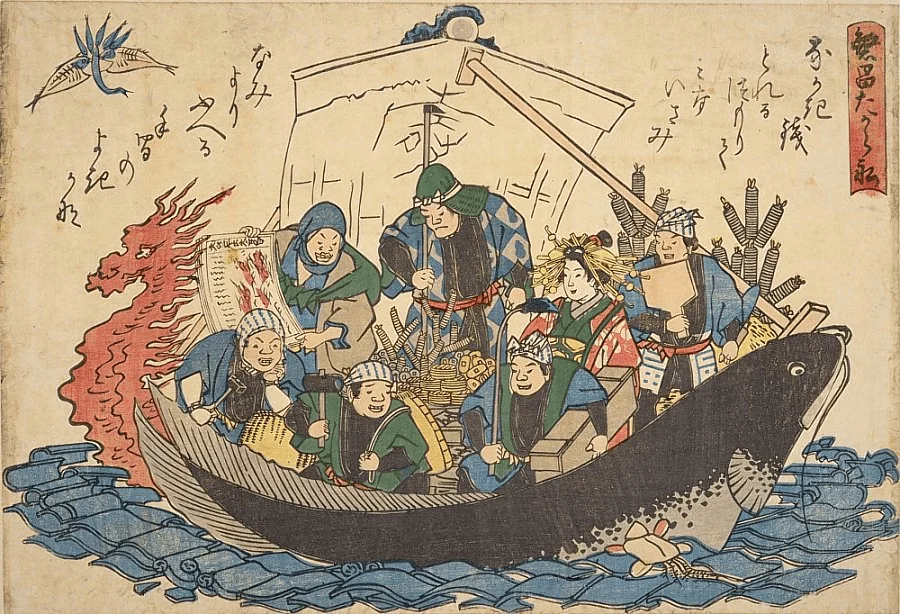
Source: onmarkproductions
The Legend of Enoshima
According to the Enoshima Engi, an ancient Japanese historical document, the Koshigoe region was once plagued by violent storms and constant earthquakes. However, the chaos eventually stopped, and a divine maiden descended from the heavens. As she was about to touch the water near Koshigoe's southern shores, an island emerged from the depths and became her new abode. This island, Enoshima, is now widely believed to be the dwelling place of the revered deity Benzaiten, who is associated with various domains such as water, speech, music, and knowledge. (Kimball)
As the legend goes, upon Benzaiten's arrival, a dragon named Gozuryu caught sight of her and was immediately captivated by her beauty. He proposed marriage, but Benzaiten knew of his terrible nature and demanded that he vow to assist the people of Koshigoe. From then on, Gozuryu devoted himself to protecting the area he once tormented. As time passed, Benzaiten recognized Gozuryu's genuine efforts, and together they nurtured Koshigoe into a flourishing community. (Kimball)
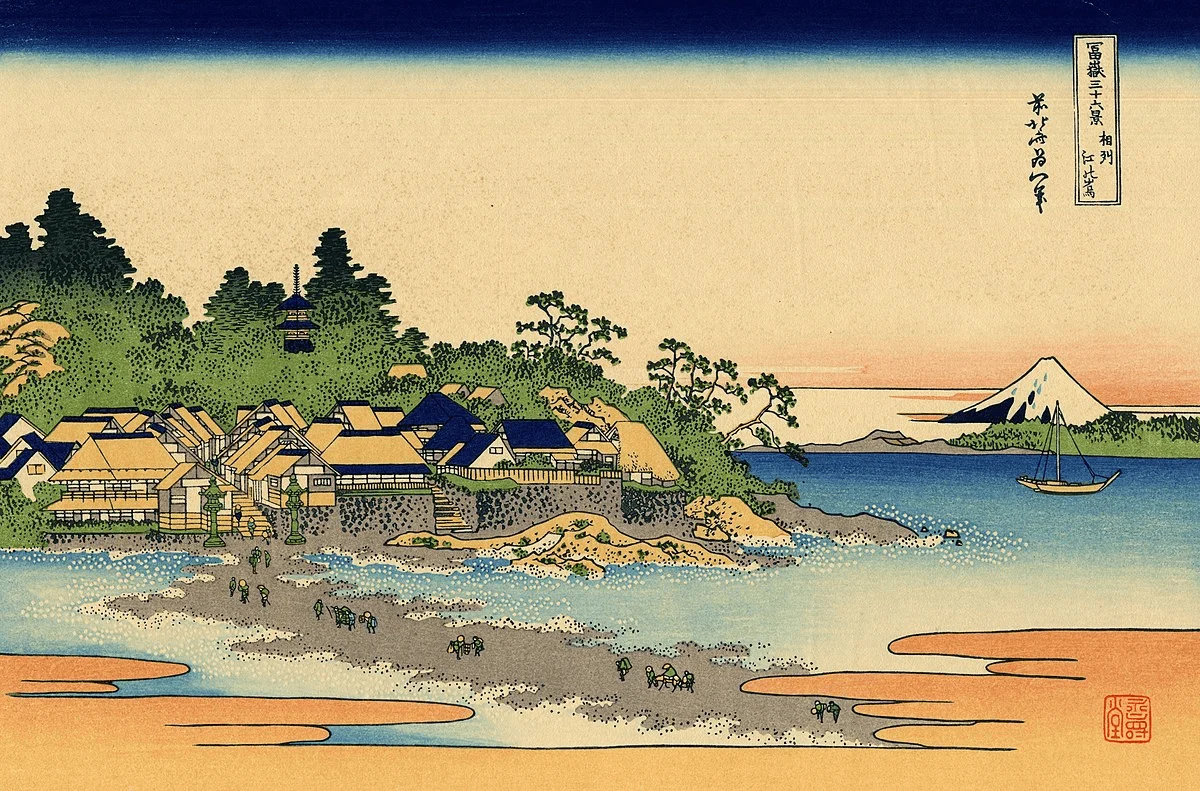
Source: Wikipedia
Chikubushima
The 10th-century Noh play "Chikubushima," tells the story of a court official from the late 9th century who embarks on a pilgrimage to the island of Chikubushima to pay homage to the goddess Benzaiten. As he arrives at the shore of the lake, he comes across an elderly fisherman and a young woman preparing to set sail in a fishing boat. The court official is intrigued and requests to join them on their journey. The fisherman and the young woman kindly agree to his request. (Fisher)
Upon reaching the island, the fisherman acts as the court official's guide, leading him to the shrine of Benzaiten. The court official is amazed by the shrine's magnificent beauty, but his admiration is short-lived when he sees the young woman approaching the shrine. He is displeased by an ordinary woman from a lower social class visiting such a sacred place and feels offended. In response to the court official's disdainful behavior, the old fisherman gently reproaches him, reminding him that Benzaiten does not discriminate based on social status or gender. The goddess welcomes all who come to pay their respects, as she is a woman. (Fisher)
It becomes clear that the fisherman and the youthful woman are not human. The woman gracefully vanishes behind a door, only to reappear as the revered deity, Benzaiten. Meanwhile, the fisherman plunges into the vast ocean, summoning Ryujin, the Dragon King of the Sea. The Dragon King then dutifully appears before the official before returning to his opulent underwater palace, having fulfilled his responsibility of safely escorting the goddess back to her holy temple. (Fisher)
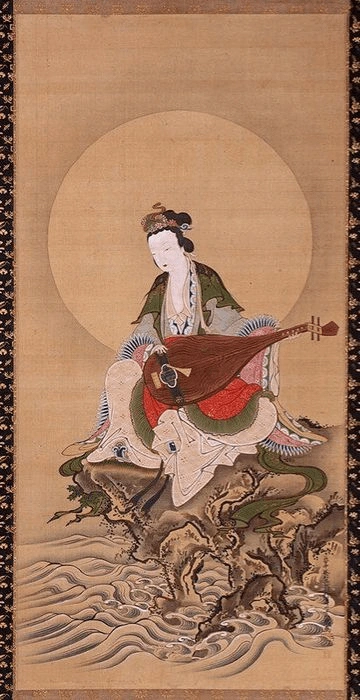
Source: Pinterest
Influences of other religions/cultures on Benzaiten
Benzaiten, a syncretic deity, is held in high esteem as a revered deity in Shindo and Buddhism, two of Japan's most popular religions. As a Buddhist deity, she has roots in Indian and Chinese traditions, particularly with Saraswati, the Hindu goddess of knowledge, arts, and music. Benzaiten's influence, however, has extended beyond these religious traditions and has been shaped by other religious and folk beliefs over time.
In Shinto, Benzaiten is a kami, a concept that refers to spirits or deities associated with natural phenomena. She is worshiped at Shinto shrines alongside other Shinto deities, signifying the influence of Shintoism on Benzaiten's syncretic identity. Implementing different elements from different religions and belief systems into her identity has contributed to Benzaiten's adaptability, making her a prominent figure in Japanese spirituality and culture.
Modern appearances
Benzaiten is a popular figure who has made a couple of appearances in various forms of pop culture. Fans may recognize her from the manga series Noragami or Akatsuki!! Otokojuku, as well as the popular video game Yo-Kai Watch. (“Benzaiten”)
Final thoughts
Benten is a deity of great complexity and depth and encompasses a rich tapestry of religious and cultural influences. Taking inspiration from the Hindu goddess Saraswati and having roots in Japanese Buddhist traditions, she is the product of varying religious and folk beliefs. As a syncretic deity, she embodies the fusion of various concepts and symbols, representing numerous essential aspects of life, including water, music, arts, knowledge, and protection. Benzaiten's inclusive nature welcomes worshipers of all social statuses and genders, transcending boundaries and fostering a profound connection with the divine. Her legends and stories continue to inspire devotion and reverence, symbolizing the harmonious integration of different religious and cultural traditions in Japan, a testament to the rich tapestry of this fascinating culture.
References
“Benzaiten.” Mythopedia, mythopedia.com/topics/benzaiten.
Fisher, Martini. “Unveiling the Mysteries of Benzaiten, Goddess of War, Music, and Culture.” Martini Fisher, 8 Feb. 2023, martinifisher.com/2023/02/08/unveiling-the-mysteries-of-benzaiten-goddess-of-war-music-and-culture/.
Kimball, Donny. “The Legend of Enoshima | the Tale of Gozuryu & Benzaiten | a Different Side of Japan.” Medium, A Different Side of Japan, 30 June 2017, donnykimball.com/enoshima-2f4a58d547ce. Accessed 27 June 2023.
link, Get, et al. Benzaiten. www.curiousordinary.com/2018/06/benzaiten.html. Accessed 27 June 2023.
Writers, YABAI. “Benzaiten (Benten): Japan’s Goddess of Reason | YABAI - the Modern, Vibrant Face of Japan.” YABAI, yabai.com/p/3200.
Izanami: The Goddess of Creation
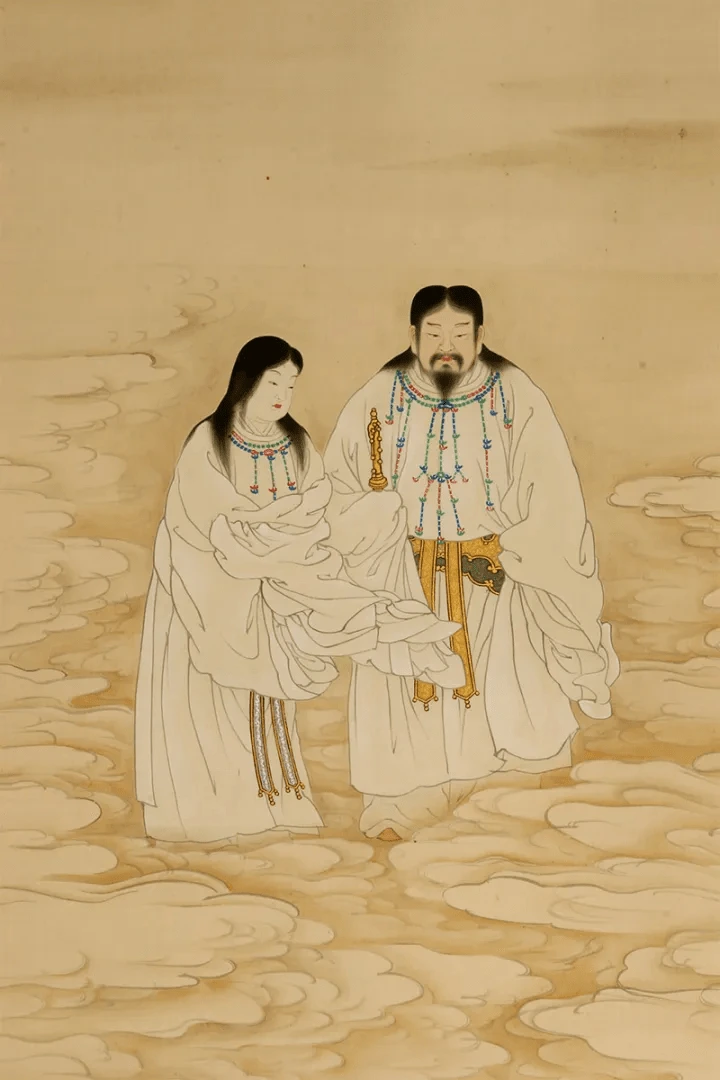
Source: Japan This!
As one of the oldest and most significant deities in Japanese Mythology and the Shinto religion, Izanami played a central role in creating the world and gave birth to many revered deities. From her mysterious emergence to her instrumental role in the formation of Japan and the kami, her story has endured through generations. Even in death, her tragic encounter and descent into the underworld of Yomi have left an indelible mark on the cultural tapestry of Japan.
Overview of Izanami
Alongside her brother and husband Izanagi, Izanami is a primordial god in the Shinto religion. Izanami-no-Mikoto (Japanese: 伊弉冉尊 or 伊邪那美命; meaning), also known as Izanami-no-kami (“Izanami”) holds a significant place in Japanese mythology as the goddess of creation. Her name translates to she who invites, and her remarkable feats include giving birth to numerous deities and creating Japan.
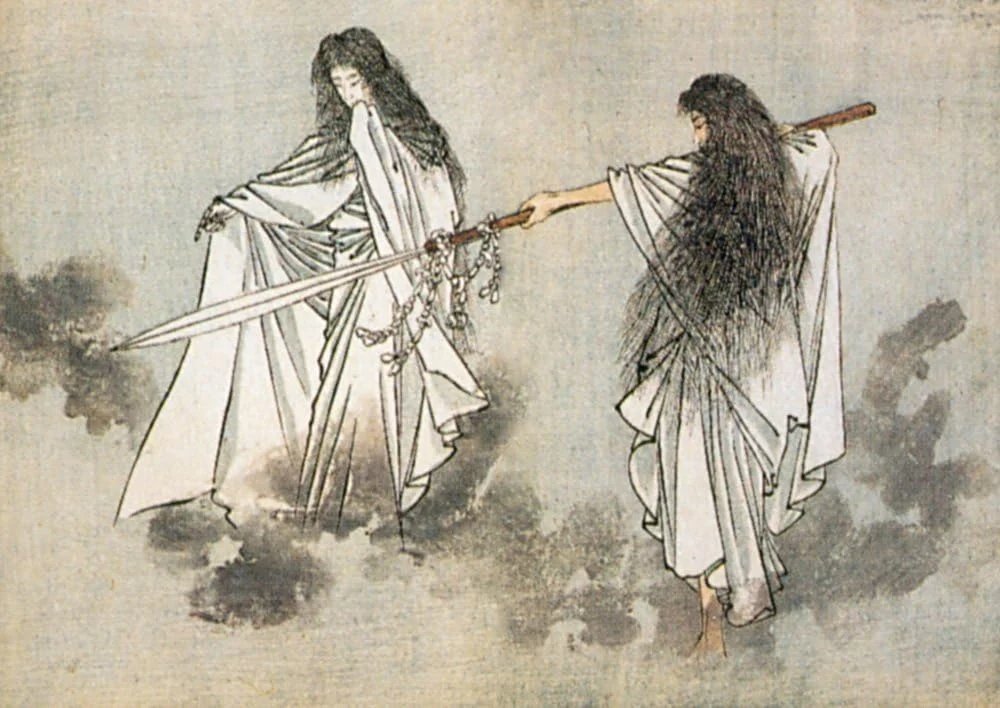
Source: Amazon
Titles
The Goddess of Creation
The Divine Weaver of Existence
Goddess of Death
Shinto Mother Goddess
Abilities
Celebrated as the divine weaver of creation and as the goddess of creation, her most notable skill is bringing forth new life. Recognized for her contribution to the creation of the Japanese Islands and being the origin of many essential and fundamental kami, she bestowed upon the world the kami of the sea, wind, trees, mountains, and other natural phenomena. Even in the throes of a painful death, Izanami gave birth to Kami from her tears of pain.
Even after her tragic demise and descent to the underworld, Yomi, the goddess of death, obtained a set of formidable abilities. These included the power of death itself and the ability to control gods and spirits dwelling within the realm of the dead (“Izanami, Japanese Goddess: Mythology & Role | Who Is Izanami-No-Mikoto?”).
Characteristics
Japanese artwork illustrates Izanami as a youthful woman with ebony hair that cascades down her back, elegantly draped in flowing robes resembling the traditional kimono. Her appearance is noteworthy for its graceful contours, and she models intricately detailed traditional garments that symbolize her divine status.
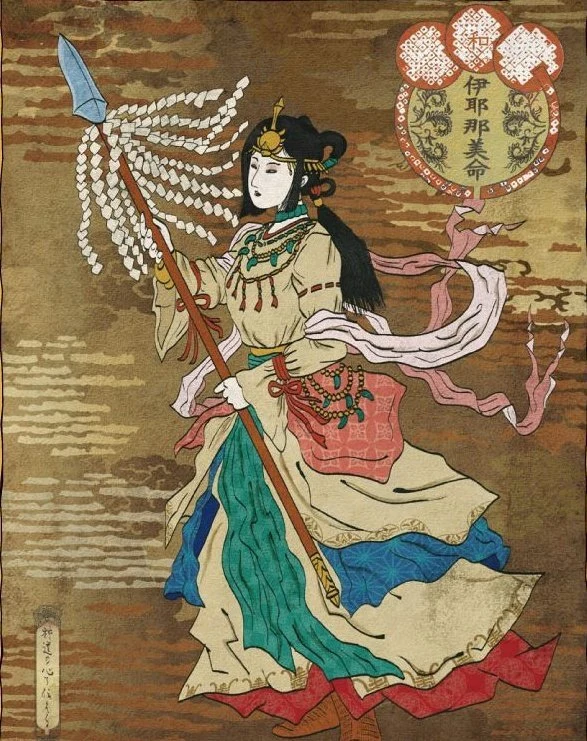
Source: X
Traits
The goddess Izanami has profound knowledge and understanding of the universe. Her wisdom comes from her significant contributions to the world’s creation and ability to maintain the realms of life and death. As the goddess of creation, her power is unmatched, and her understanding of the realm of death is unparalleled. Izanami can cross both domains making her one of the most respected and admired deities in Japanese mythology.
Symbols
Izanami reigns supreme as the embodiment of creation. Among the many symbols associated with her, one of the most prominent is the Ama no Nuboko, a spear encrusted with precious jewels. According to many myths, Izanami and her partner, Izanagi, used this weapon to create the first islands of Japan, bringing forth land from the endless expanse of the sea.
Another powerful symbol of Izanami’s creative force is weaving tools. These tools include looms, shuttles, or threads: all symbolize the goddess’s ability to shape the very fabric of existence itself. Through her skill as a weaver, Izanami can craft the intricate patterns and textures of the cosmos, bringing forth new life and imbuing the world with meaning and purpose.
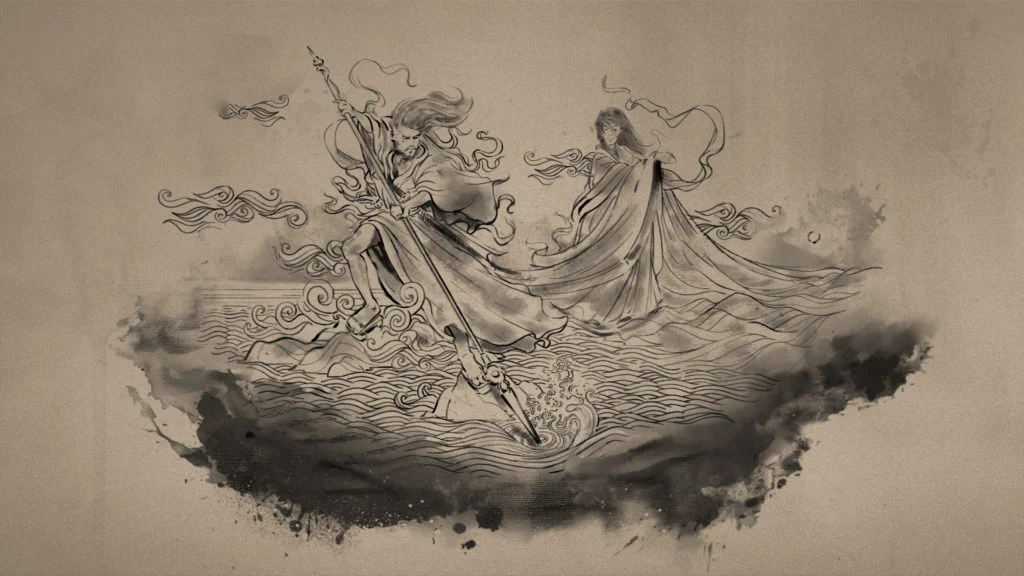
Source: Taleofronin
Festivals and Rituals
Obon, also known as お盆 in Japan, is an essential holiday that follows New Year’s Day. As a Buddhist festival, Obon is celebrated in mid-August to welcome the spirits of ancestors. According to Buddhist belief, during this occasion, the souls of our ancestors come to visit and are revered (“What Is Obon?”). As such, Izanami, the goddess of death, is often remembered and honored during Obon.
To commemorate this festival, people perform various rituals, visit ancestral graves, and offer food, drinks, and incense to honor the departed. It is a time to respect our ancestors and seek blessings from the Shinto mother goddess. Obon is a time to connect with our roots, family, and history. This festival highlights the importance of honoring and remembering those who came before us and acknowledging their role in our lives.
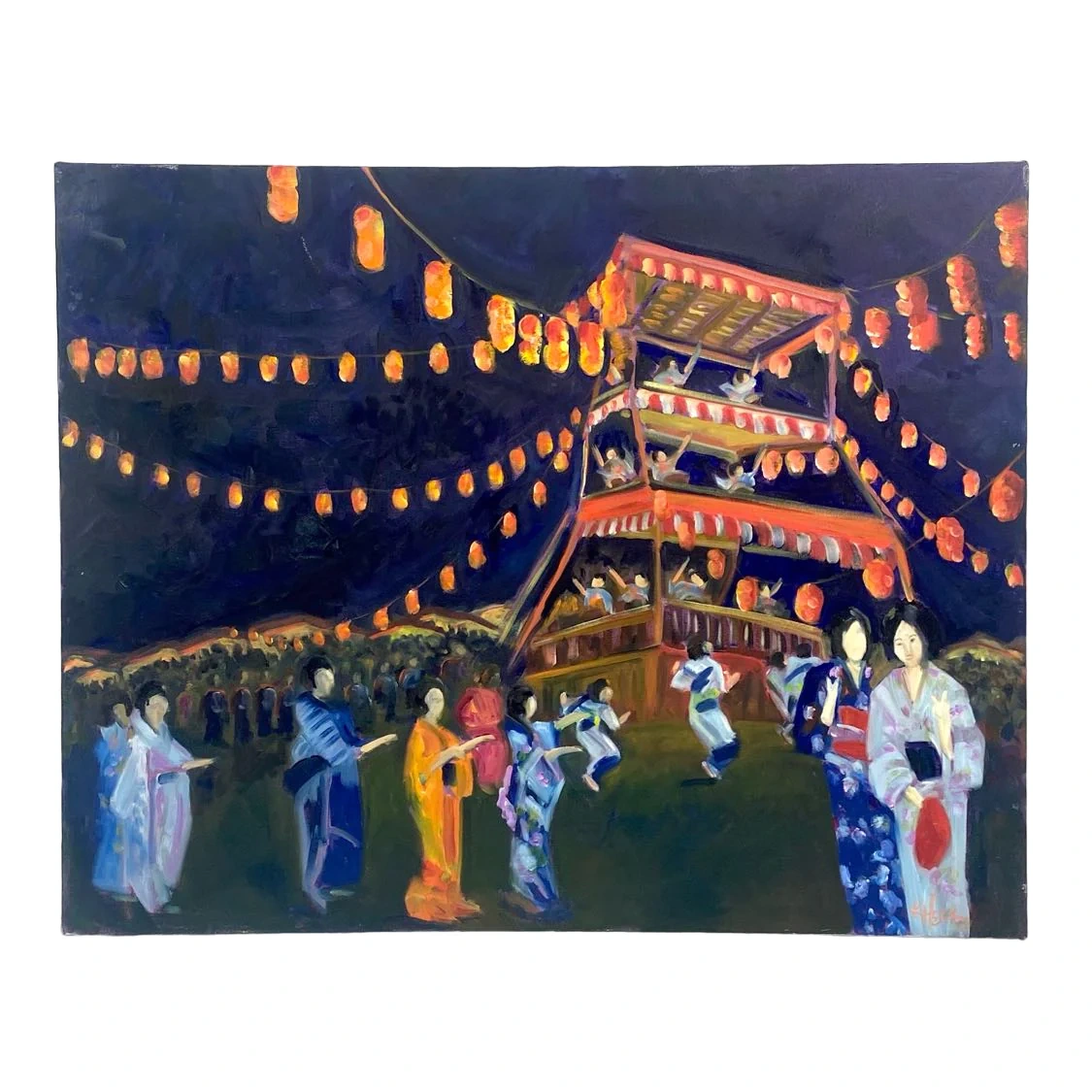
Source: Found Furnishings
Legends associated with Izanami no mikoto
The goddess of creation has been a prominent character in Japanese history, captivating many with her enchanting myths and legends. These timeless tales, with their various interpretations and renditions, provide us with profound insights into the life and persona of the goddess. By delving deeper into these captivating stories, we gain a greater understanding the impact of the Shindo Mother Goddess.
Origin story
The world’s creation began by separating the heavens and earth from a state of chaos. On the Heavenly floating bridge, two deities named Izanami and Izanagi appeared to bring order and structure to the shapeless universe. Izanami, who appeared alongside her brother and husband Izanagi, was believed to be the eighth and final pair of brother and sister deities to be born before the world’s formation. It was the responsibility of Izanagi and Izanami, as assigned by the older generations of kami, to bring harmony to the world and establish a sense of balance amidst the chaos (SarahLMaguire).
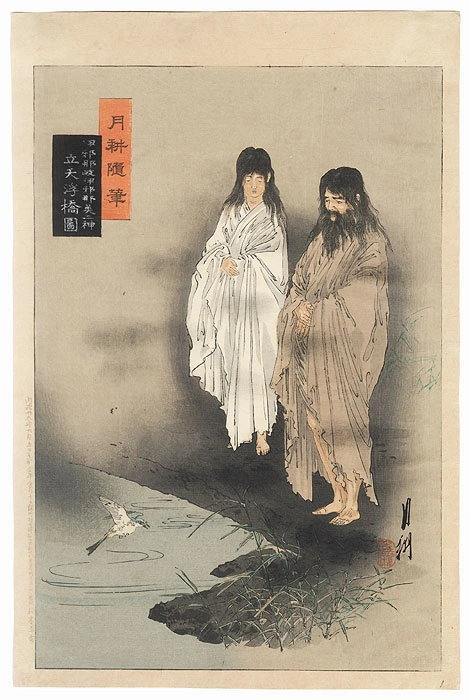
Source: Fujiarts
The Creation of Japan
In the ancient mythologies of Japan, the world was once a blob of shapeless chaos devoid of any order or structure. To bring about some semblance of harmony, the older generations of gods assigned the task of creation to the divine couple, Izanagi and Izanami. The gods gave them a jeweled spear known as Ama no Nuboko to help them in their mission.
The celestial bridge or stairway connecting the realms of heaven and earth, also called Ama-no-hashidate (SarahLMaguire), served as the stage for the cosmic act of creation. Standing on this bridge, Izanami and Izanagi no Mikoto stirred the vast expanse of the ocean below. Pulling the spear out of the water, salt crystals formed into tiny droplets on the pointed tip. These delicate droplets soon began to fall back into the vast ocean below, creating a breathtaking display of islands.
The first island was Onogoro-Shima. The gods immediately used this island to build a house and host their wedding ceremony. It was on this sacred island that Izanami and Izanagi, the primordial gods, went on to create the eight principal islands of Japan – Awaji, Shikoku, Oki, Tsukushi (Kyushu), Iki, Tsu, Sado, and Oyamato. The creation of these islands played a vital role in the formation of Japan’s geography and culture.
Apart from the islands, the divine couple also created many gods. More than 800 kami exist under the Shinto religion, each with its unique role and significance. Some notable children born to Izanami and Izanagi were Oho-wata-tsu-mi (god of the sea), Kuku-no-shi (god of the trees), Oho-yama tsu-mi (god of the mountains), and Kagutsuchi (god of fire) (Cartwright).
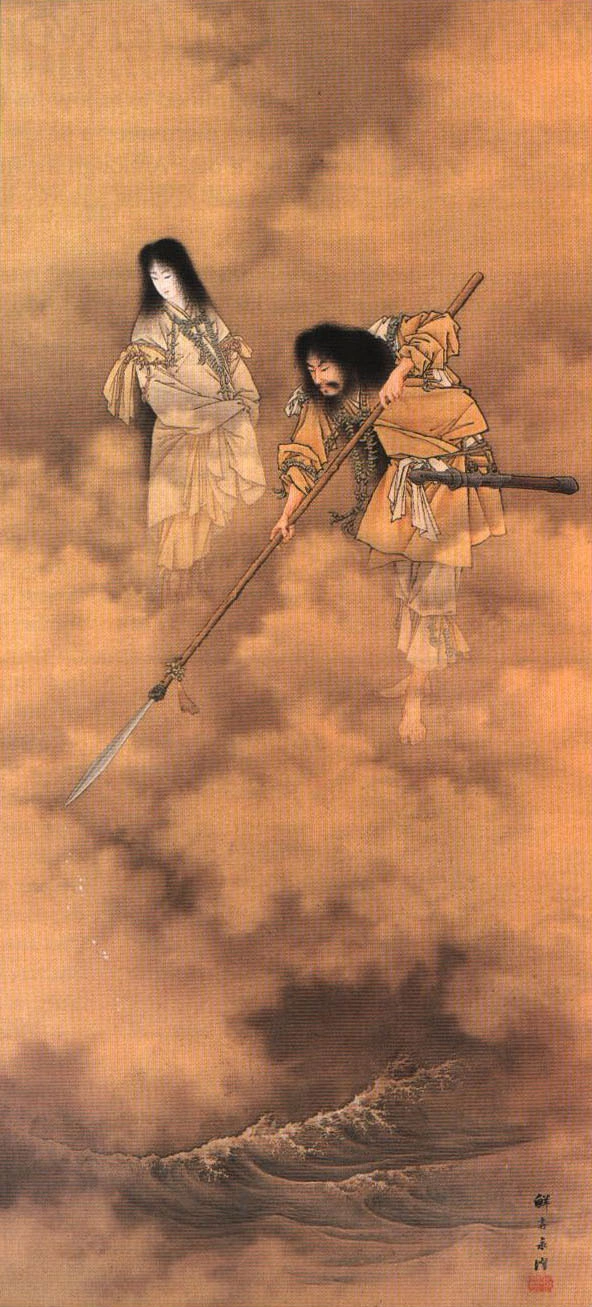
Source: Wikipedia
The Death of Izanami No Mikoto
The passing of Izanami is a significant and sorrowful moment in Japanese mythology. During the birth of her son, Kagutsuchi (the fire god), Izanami was severely burned and suffered immensely from her injuries until her eventual death. As a result of her anguish, many other divine beings were born from her tears. Izanami’s death brought Izanagi no Mikoto immense sadness and hopelessness. Overwhelmed by his sorrow, he set out on a quest to the underworld, known as Yomi, in a desperate attempt to bring Izanami back to the living. However, upon finally discovering her in the realm of the dead, he was horrified to find that she had transformed into a ghastly and decaying figure, surrounded by the spirits of the deceased. When Izanagi no Mikoto asked for Izanami’s return, she told him that she had already eaten the food of the underworld and was now stuck there. He was upset by her appearance and the fact that she could never leave, so he left Yomi and blocked the entrance with a boulder to keep Izanami from following him (Cartwright).
This devastating incident highlights how goddess Izanami embodies the duality of being both a creator and a guardian of death, symbolizing the cyclical essence of life and the balance between creation and destruction. The story of Izanami’s death and her journey into the underworld has become a significant aspect of the Shinto religion, shaping how the culture views life, death, and the afterlife.
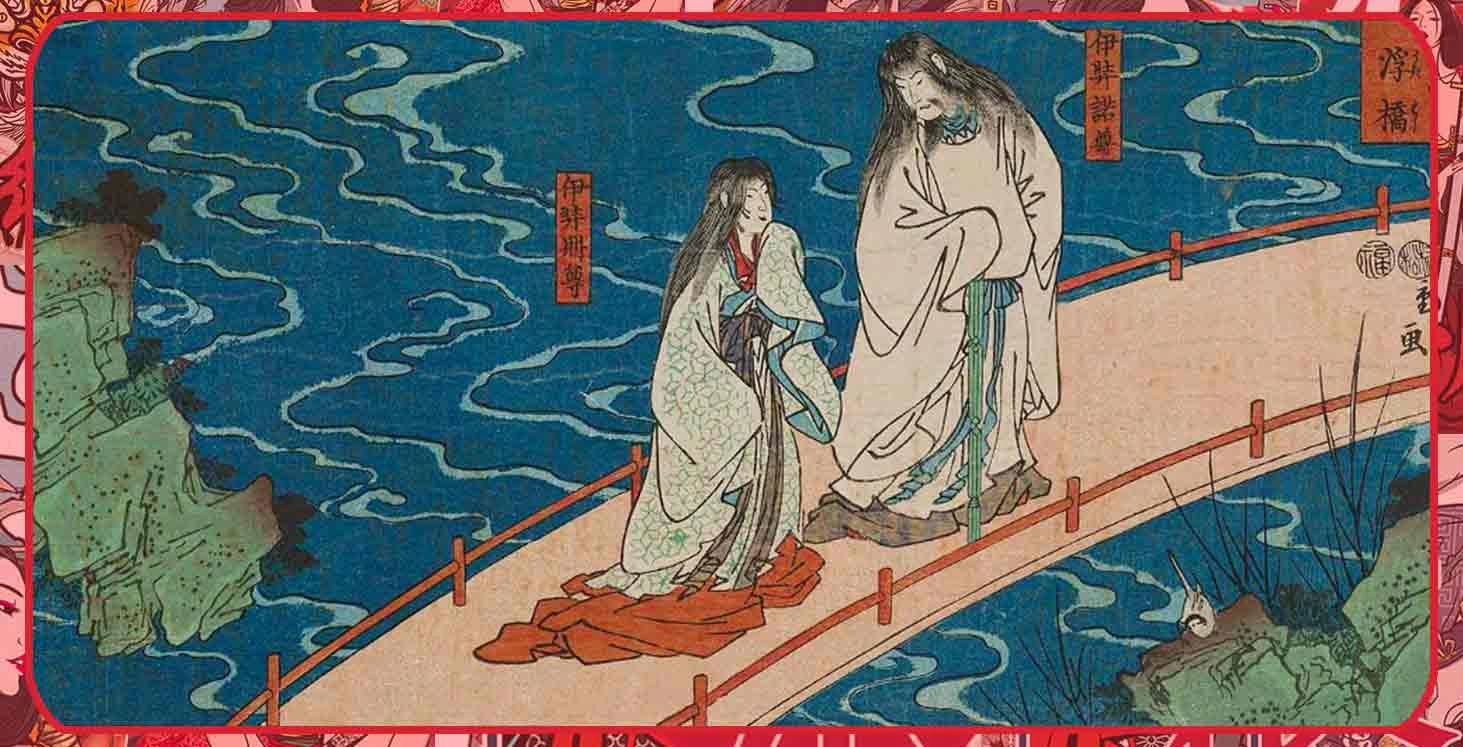
Source: KimuraKami
Modern appearances
Concerning modern appearances, Izanami is present in the famous anime Naruto. Within the Naruto anime universe, Izanami is a powerful technique that utilizes the Dōjutsu abilities of a skilled ninja. This ability shows a loop of specific events to the victim and determines the victim’s fate. The primary goal of Izanami is to encourage the victim to accept their predetermined fate naturally, thus preventing any potential misuse of the ability, which could result in the removal of the boundary between reality and illusion (“Izanami”).
Final thoughts
Izanami, a prominent figure in the folklore of Japan, has left an indelible mark on the country’s cultural landscape. Her story has served as a source of inspiration for countless writers, poets, and artists who have found in her life a powerful symbol of the enduring connection between the divine and the human experience. Through her mythological influence, Izanami continues to be a testament to the enduring power of storytelling, which can transcend generations and shape how we understand ourselves and the world around us.
References
Cartwright, Mark. “Izanami and Izanagi.” World History Encyclopedia, 6 Dec. 2012, www.worldhistory.org/Izanami_and_Izanagi/.
“Izanami.” Myths and Folklore Wiki, mythus.fandom.com/wiki/Izanami.
“Izanami, Japanese Goddess: Mythology & Role | Who Is Izanami-No-Mikoto?” Study.com, 2023, study.com/academy/lesson/izanami-japanese-goddess-mythology-role.html#:~:text=Izanami%20is%20a%20Japanese%20creation.
SarahLMaguire. “The Story of Izanagi and Izanami: A Japanese Creation Myth.” Owlcation, Owlcation, 28 Apr. 2011, owlcation.com/social-sciences/IzanagiandIzunami.
“What Is Obon?” Jw-Webmagazine.com, 20 July 2022, jw-webmagazine.com/obon-in-japan/.
Kannon: Goddess of Mercy
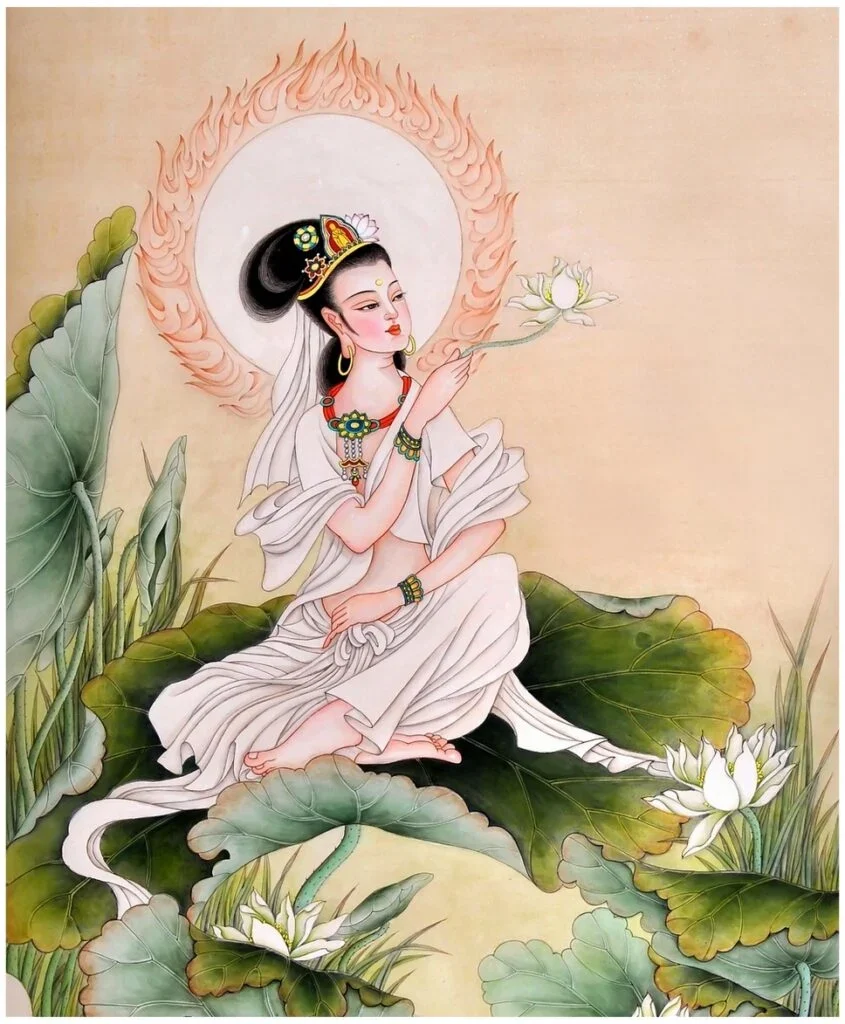
Source: Thanhamthugian
The Kannon Bodhisattva occupies an esteemed position in Japanese Buddhism, symbolizing the personification of compassion, mercy, and enlightenment. Bodhisattva refers to someone who achieves enlightenment but postpones Buddhahood until everyone is on the path to salvation. Kannon’s tales recount her struggle to rescue all living beings from the cycle of life and suffering, and the story of the Thousand-Armed Kannon illustrates how firmly rooted she is in ancient mythology. Kannon’s continued presence in present-day spiritual practices is a source of inspiration and guidance for millions of individuals in Japan and beyond.
Overview of Kannon
The Kannon Bodhisattva, known as the Kanzeon or Kuan Yin, has various names and embodiments in different cultures and traditions. Kannon is the contemporary Japanese interpretation of Guanyin. In its original form, Guanshiyin means “One Who Perceives the Sounds of the World,” a direct translation of Kannon’s primary Indian name, “One Who Perceives All.” However, the proper Japanese name for Kannon is Kanzeon Bosatsu. In Japanese mythology, Kannon takes on divine characteristics and is a popular deity, perhaps the most widely worshiped bodhisattva in Japan revered across Eastern and Southern Asia (“Kannon”).
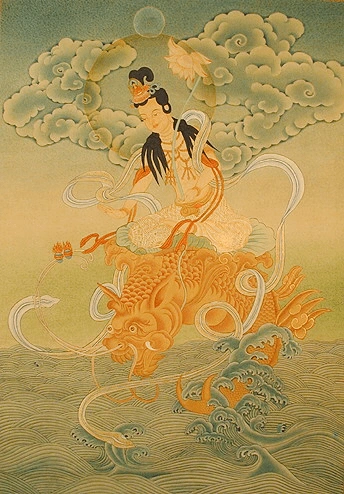
Source: Onmarkproductions
Titles
Bodhisattva of Compassion.
Savior from Suffering
Goddess of Mercy
Abilities
The Kannon Bodhisattva is a revered deity in Japanese Buddhism and represents divine nature and compassion. Kannon possesses extraordinary abilities that demonstrate her divine nature and compassionate qualities. One of her most prominent abilities is having the power to hear the pleas and suffering of all beings and respond to their prayers with compassion and mercy. Devotees turn to Kannon for healing and seek solace in times of illness, believing in the bodhisattva’s power to provide physical and spiritual healing. In addition, Kannon oversees fertility and grants blessings for safe childbirth and the well-being of children (“Kannon Bodhisattva (Bosatsu) – Goddess of Mercy, One Who Hears Prayers of the World, Japanese Buddhism Art History”).
Characteristics
Originally depicted as male, modern-day Kannon often appears as a female in China, Japan, and other East Asian countries. Each nation dressed Kannon differently, reflecting their own temperaments and spiritual concepts. Additionally, Kannon can take on thirty-three different forms, including one with a thousand arms and a horse-headed form, in which she protects pets in the afterlife. In the Lotus Sutra (a sacred text of Buddhism), Kannon can take the form of any god or bodhisattva in India. In Japanese art, Kannon sometimes is shown holding a magic jewel, a Nyoi Hoju, on which she makes wishes for the world. At times, she has a multi-armed form, holding many symbols of Buddhism, including weapons, and is depicted with as many as eleven heads, drawing on the imagery of naga (mythical serpent beings). The praise-worthy Kannon Bodhisattva possesses a compassionate nature, extraordinary abilities, and unique characteristics, which all help her in that her an important symbol of Japanese Buddhism (“Kannon”).
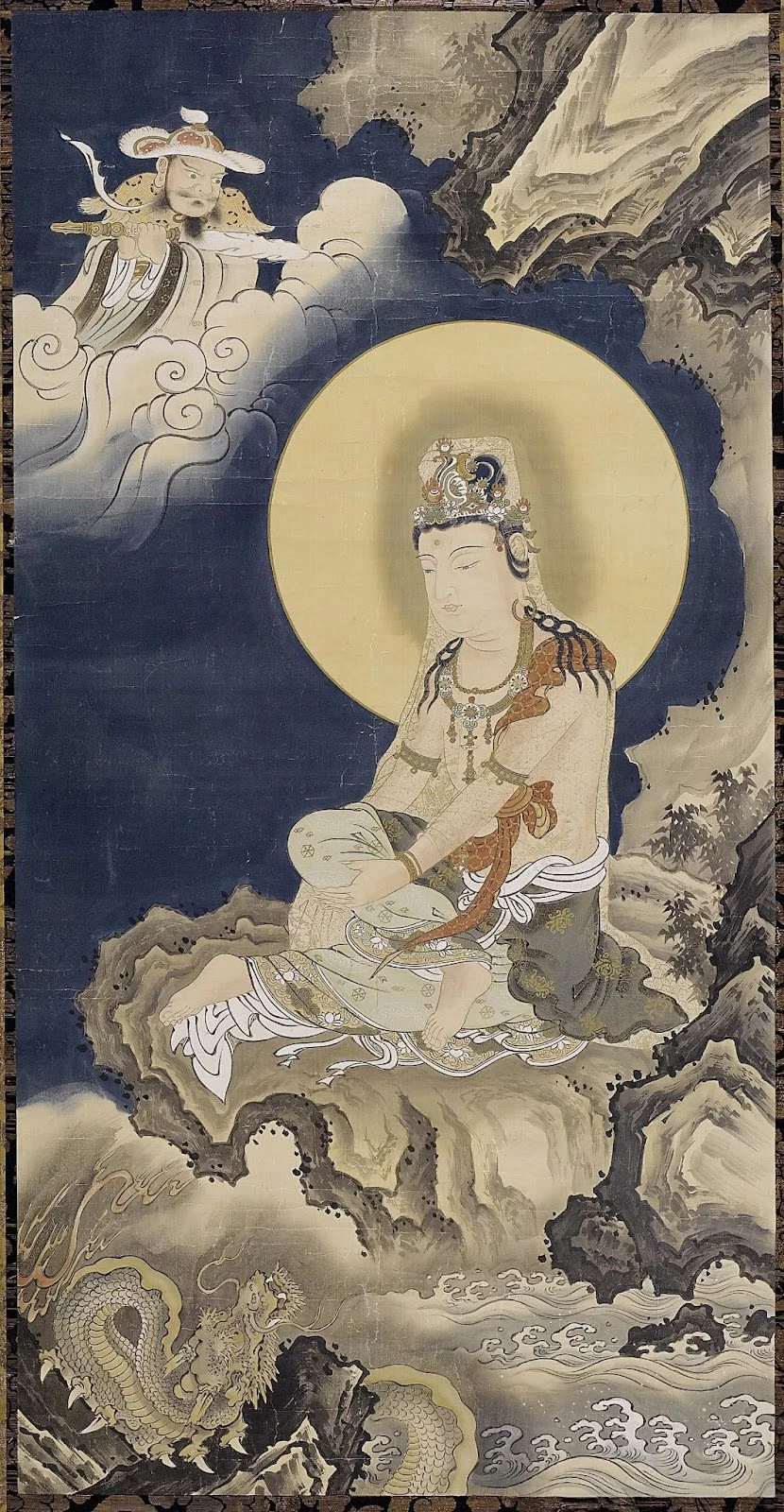
Source: MutualArt
Traits
Kannon, the revered bodhisattva of compassion and mercy, is widely recognized as the keeper of peace and the reliever of troubles. Her virtuous personality traits inspire devotion and admiration among followers, as she embodies the importance of empathy and kindness. Kannon’s boundless compassion is the foundation of her role as a savior and protector of all beings, while her profound wisdom guides devotees on the path toward spiritual awakening. Her selflessness is an exemplary model for practitioners, encouraging them to transcend ego-driven desires and embrace altruism.
Symbols
Deeply rooted in Buddhist iconography, the Kannon Bodhisattva has various symbols of significant spiritual meaning. The lotus flower, a powerful metaphor for spiritual purity and awakening, represents Kannon’s ability to transcend the cycle of birth and death. The vase of compassion, held in her hands, contains water, from which she pours out mercy to alleviate the suffering of beings and bestow blessings upon them. In many illustrations, Kannon holds a string of prayer beads, symbolizing the continuous recitation of mantras and the cultivation of mindfulness. These symbols enhance Kannon’s visual representation and remind devotees of her compassionate nature and her role in guiding them toward enlightenment.
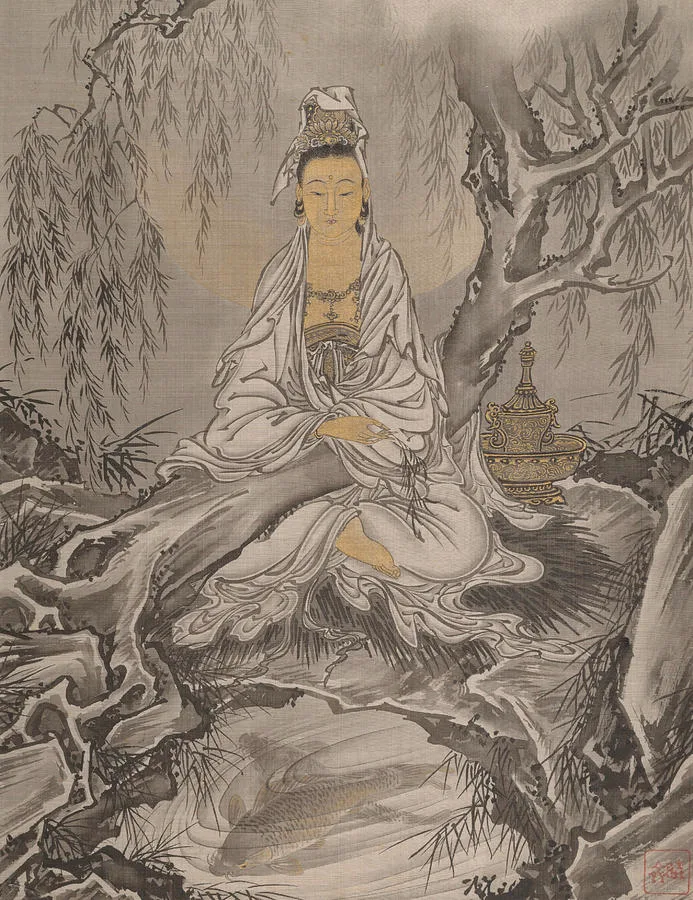
Source: Fine Art America
Festivals and Rituals
People celebrate Kannon throughout the year in various festivals and rituals, such as the Kannon Matsuri held in Japan. Devotees gather to express their gratitude and seek blessings from the compassionate bodhisattva. The ceremonies involve offering prayers, lighting incense, and donating at Kannon temples, signifying their devotion and desire for spiritual guidance. Kannon worship is essentially non-denominational and widespread, as she is worshiped independently as a savior par excellence by many sects, including Japan’s Pure Land Sects, the Nichiren sect, the Zen sect, the Tendai and Shingon sects of Esoteric Buddhism, and nearly all Buddhist sects (“Kannon Bodhisattva (Bosatsu) – Goddess of Mercy, One Who Hears Prayers of the World, Japanese Buddhism Art History”). The statues of Kannon made in Japan since the early days after the introduction of Buddhism during the Asuka Period are now registered as National Treasures, attesting to her enduring influence and significance in Buddhist culture (“Kannon Goddess of Mercy | Japan Experience”).
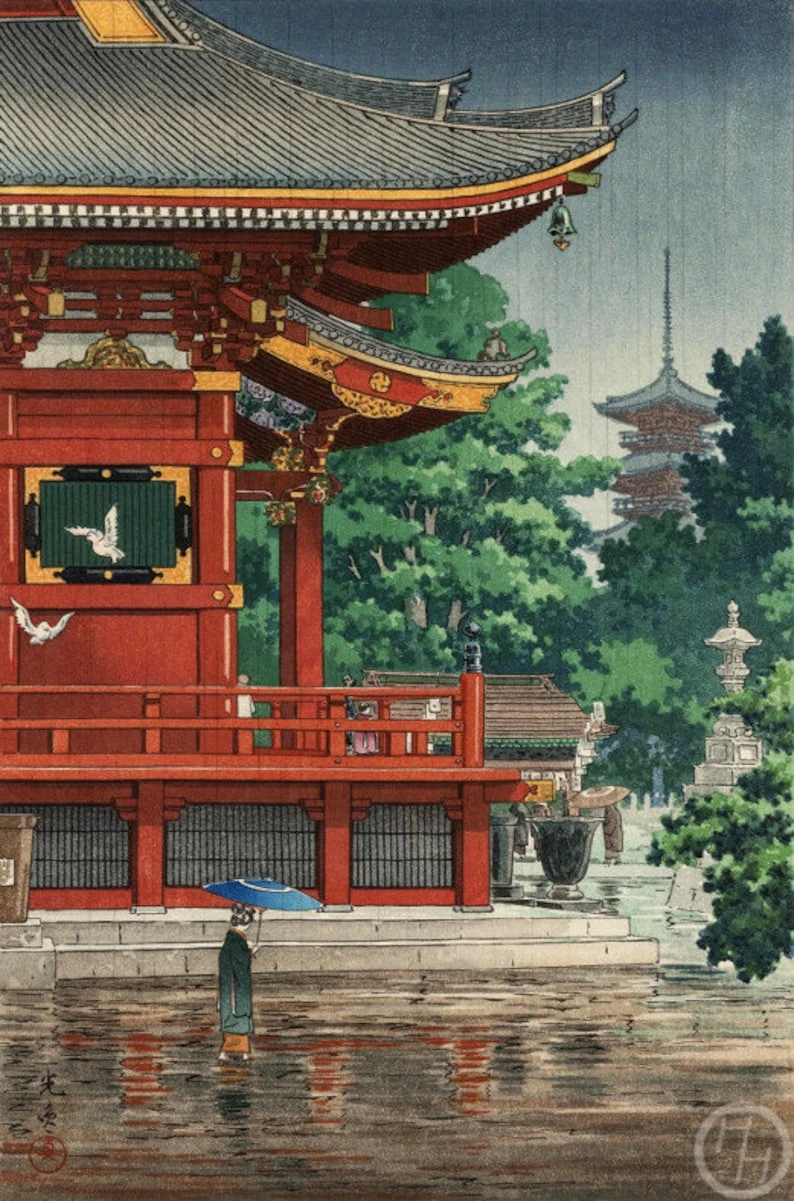
Source: Etsy
Legends associated with Kannon
The Kannon Bodhisattva has many legends that enhance her character and offer a deeper understanding of her origins and significance. Although various tales are associated with this divine figure, some are better known than others.
Origin story
The origin story of the revered Kannon Bodhisattva varies among different sources. One version recounts that Kannon was born from a tear shed by Amitabha Buddha, who was stricken with grief after witnessing how humans experienced such immense agony and suffering. This tear transformed into Kannon, who then vowed to alleviate suffering and lead beings to enlightenment (“Kannon Bodhisattva (Bosatsu) – Goddess of Mercy, One Who Hears Prayers of the World, Japanese Buddhism Art History”). Similar to the religion of Buddhism, what scholars know for sure is that Kannon, similarly to Buddhism, also originated in India with the deity Avalokiteshvara. As Buddhism spread into China, it is likely that the religion blended with local Taoist goddesses and eventually became known as Guanyin. Guanyin originates from the Japanese word Kannon (“Kannon Goddess of Mercy | Japan Experience”). The various origin stories of Kannon demonstrate the profound influence of Buddhism on many cultures throughout history.
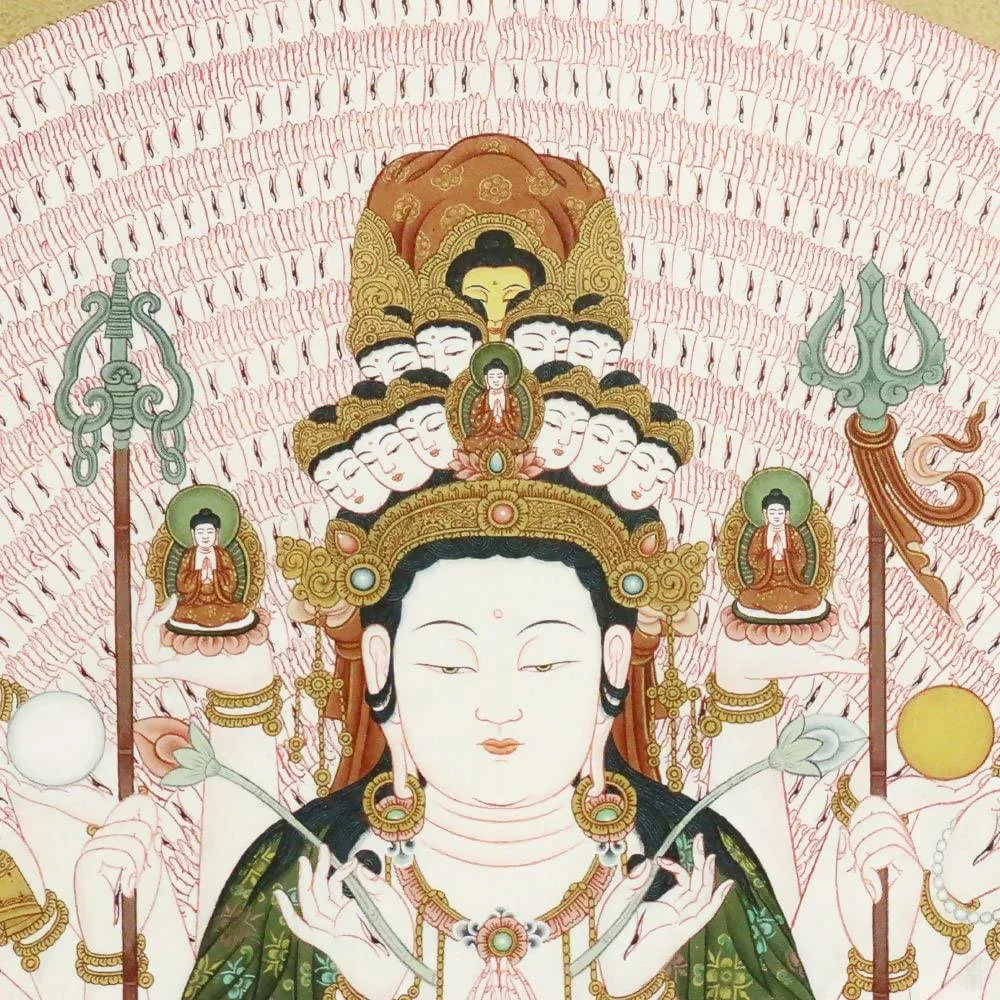
Source: Allegro Japan
The Thousand-Armed Kannon
There was a prince who became disheartened by the suffering and agony he witnessed in the world around him. Wanting to make a difference, he renounced his royal status and devoted himself to enlightenment. Through intense devotion and rigorous practices he reached enlightenment and transformed into the Thousand-Armed Kannon. Each arm symbolizes a compassionate act, exemplifying her ability to reach out and assist countless beings at once. The legend is a powerful story of compassion and empathy, inspiring many to follow in the prince’s footsteps and strive for enlightenment (“Kannon Goddess of Mercy | Japan Experience”).
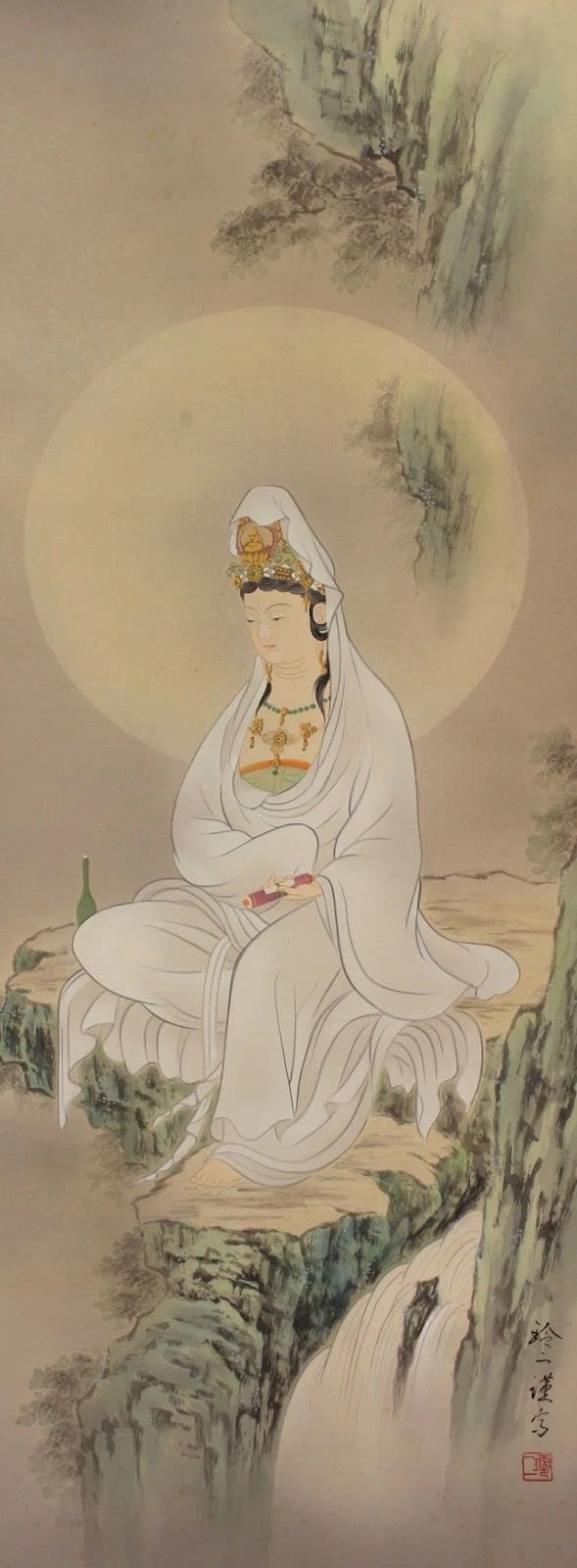
Source: Etsy
Life and Suffering
In one story, Kannon struggled with her mission to liberate all beings from the cycle of samsara, or birth and rebirth, and the accompanying suffering. She became overwhelmed by the task, feeling powerless to save everyone. In response to her struggle, Amida Buddha, a prominent figure in some Buddhist traditions, bestowed upon Kannon eleven heads and a thousand arms. With these additional appendages, Kannon could see, hear, and perceive everything, enhancing her ability to help everyone. As a result, Kannon is often depicted in art with multiple arms and heads, representing her expanded capacity to see and serve all beings (“Kannon”).
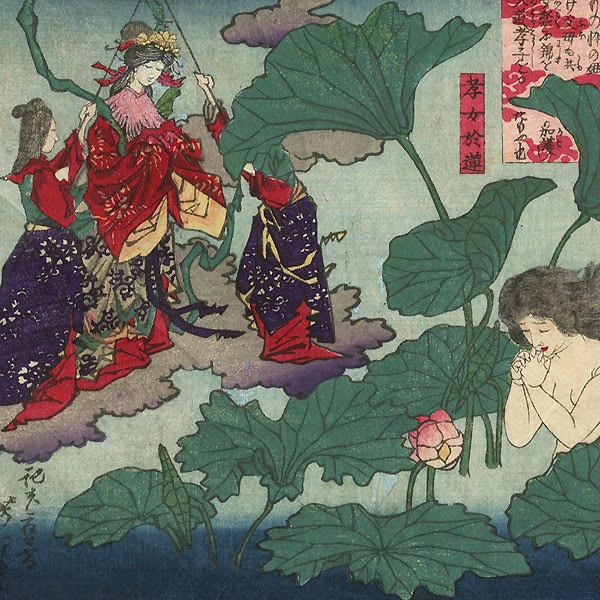
Source: Fuji Arts
Influences of other religions/cultures on Kannon Bodhisattva
Throughout history, the perception of the Kannon Bodhisattva has evolved and been shaped because of external influences, including other religions and cultures. One notable example is the interaction between Buddhism and indigenous beliefs in Japan, which has played a significant role in defining the understanding of Kannon in that country. Specifically, the blending of Shintoism, Japan’s indigenous religion, with Buddhism has resulted in a syncretic form of worship that centers around Kannon. This fusion has helped establish Kannon as a compassionate and benevolent deity who protects and guides everyday individuals. The resulting perception of Kannon has impacted Japanese culture and society and continues to be a vital aspect of spiritual life in Japan to this day (“Kannon Goddess of Mercy | Japan Experience”).
Modern appearances
Kannon, and its counterpart Guanyin, are highly regarded entities in Buddhism and are frequently depicted in both religious and popular contexts. The imagery of Kannon is widely recognized in various forms of artwork and serves as a significant symbol in Buddhist iconography. One of the most iconic portrayals of Kannon is as Guanyin in the celebrated 16th-century Chinese novel Journey to the West. This epic tale has inspired countless adaptations, including the popular television show, The New Legends of Monkey, and the media franchise, Dragon Ball, where Guanyin’s character continues to enthrall audiences. The influence of Kannon extends beyond the religious and literary realms, permeating into everyday life and modern culture. It is worth noting that the Japanese photograph and imaging company, Canon, derived its name from Kannon. The choice of this name is rooted in the deity’s association with all-seeing abilities, which mirrors the company’s commitment to producing advanced and visionary imaging technology (“Kannon”).
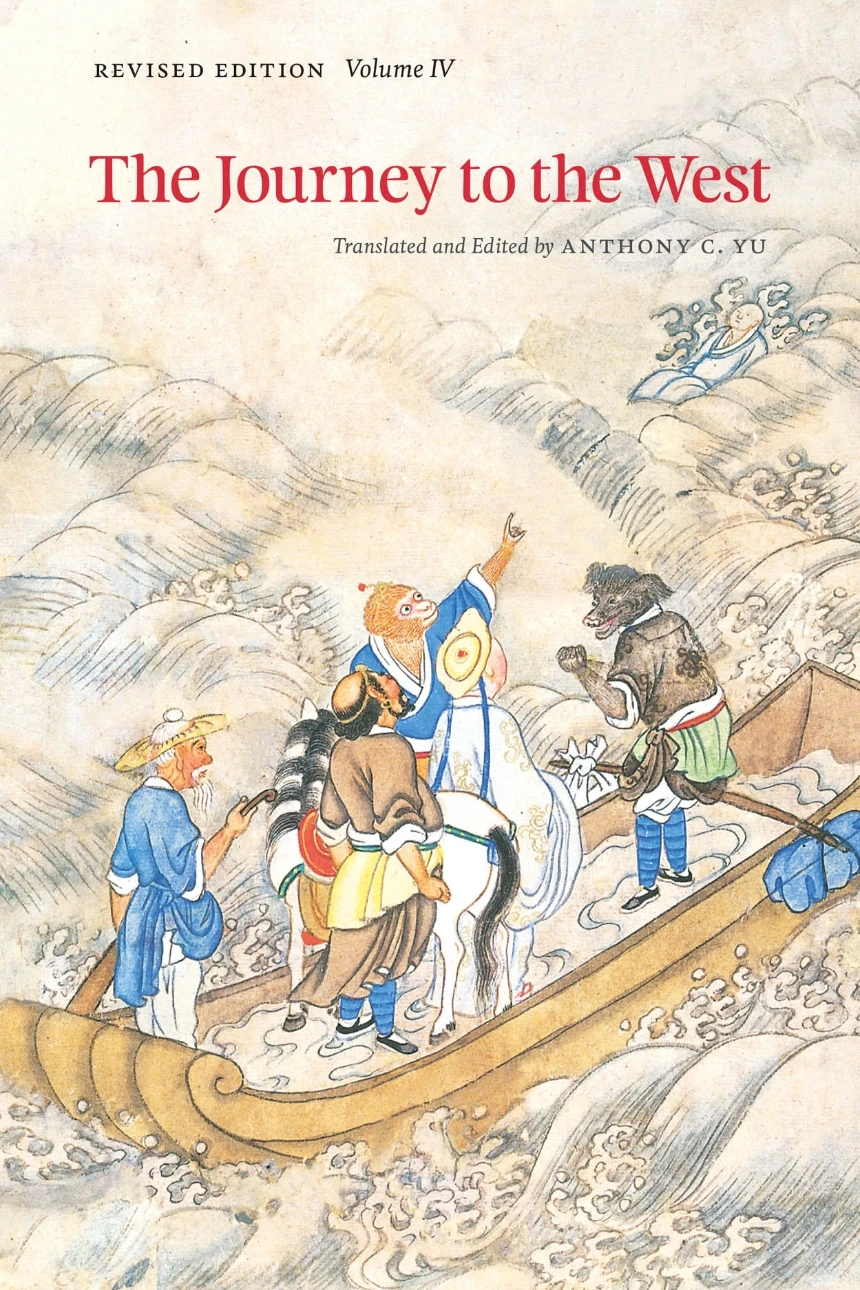
Source: The Journey to the West, Revised Edition, Volume 4
Final thoughts
The Kannon Bodhisattva, a prominent figure in Buddhist mythology, boasts a rich and fascinating history that holds great significance within Japanese culture. With a synthesis of Buddhism and indigenous beliefs, Kannon has come to embody qualities such as compassion, mercy, and spiritual guidance, making her a beloved and revered symbol for Buddhists and non-Buddhists alike. As Kannon continues to inspire and captivate devotees, her presence can be felt in various forms of art and popular culture, reaffirming her timeless relevance and enduring impact on those seeking solace, enlightenment, and a deeper connection to the divine.
References
“Kannon.” Mythopedia, mythopedia.com/topics/kannon#popular-culture. Accessed 9 July 2023.
“Kannon Bodhisattva (Bosatsu) – Goddess of Mercy, One Who Hears Prayers of the World, Japanese Buddhism Art History.” Www.onmarkproductions.com, www.onmarkproductions.com/html/kannon.shtml.
“Kannon Goddess of Mercy | Japan Experience.” Www.japan-Experience.com, www.japan-experience.com/plan-your-trip/to-know/understanding-japan/kannon.
Like this project
Posted Sep 16, 2023
A client hired me to write several informative pieces centered around the goddesses Kichijoten, Kannon, Izanami, Inari, and Benzaiten.
Likes
0
Views
3.1K




